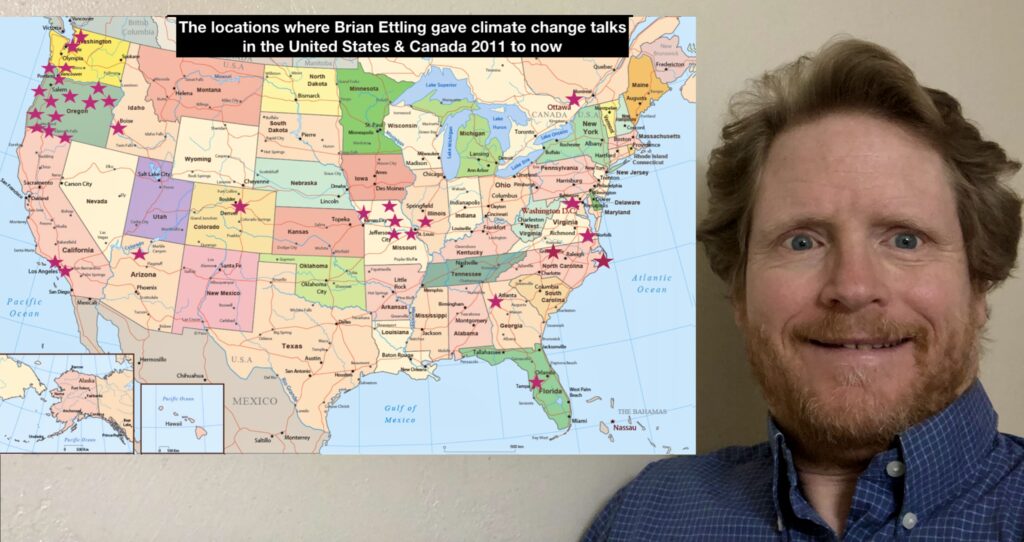
“Stand before the people you fear and speak the truth even if your voice shakes.”
– Maggie Kuhn, American activist and founder of the Gray Panthers movement.
Ever since I was in grade school, I loved public speaking. As an adult, I found a dream job giving daily talks as a seasonal park ranger at Everglades National Park, Florida and Crater Lake National Park, Oregon from 1992 to 2017. While working in the national parks, I found my true passion of organizing, writing, and giving public presentations for climate action. Since 2010, I have given over 200 climate change talks in 12 U.S. states, plus Washington D.C. and Ottawa, Canada. This blog is about each of those locations where I gave climate presentations.
I enjoy traveling and giving talks that hopefully inspire people to act on climate. If you are reading this blog, I hope you will invite me to come speak in your area.
My first memories of enjoying public speaking at grade school in 1981
I grew up in Oakville, Missouri which is a suburb on the southern end of the St. Louis metropolitan area. In grade school, I had a hard time distinguishing myself from the other students. I was not athletic. Heck, in gym class I was not even the last kid picked for the sports teams. After everyone was picked, I just had to go to whichever side noticed less that I was on their team.
I was not a very studious or bright scholastic achiever. I would often procrastinate or even forget sometimes to do my homework. I watched way too much TV. My 3rd grade teacher admonished me on my report card that I was more interested in staring at the horses and fields outside the window than what was going on in the classroom. My mom was not happy reading that on my report card. To be honest, sorry teacher and mom, the horses and outside nature was more interesting than anything happening in the classroom.
I was a dreamer in grade school who could not wait to explore the woods and be outside riding my bike during summer vacation. I grew up in the late 1970s. Star Wars was the cultural rage at the time. Hence, my mind was often drifting into “a long time ago in a galaxy, far, far away…”
I took piano lessons late in my grade school years, but I was not disciplined at practicing the piano. Thus, I never developed that talent. I didn’t particularly like Sunday School, Vacation Bible School or going to church. As a kid, I did not connect with religion. Thus, I was a class clown in those settings, always rebelling against any spiritual teaching. My Sunday teachers thought I was ‘hell on wheels’ or the devil incarnate.
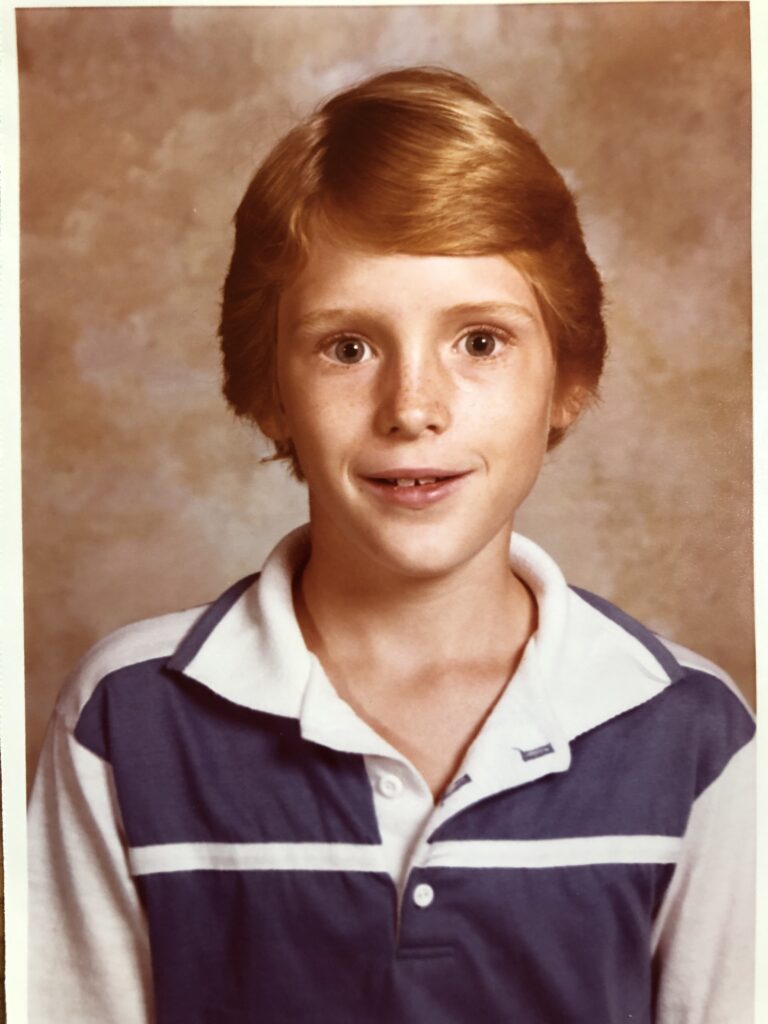
At school, I was not witty enough to be a class clown. I was rather shy. My grade school classmates did not know what to think of me, except I was rather odd. Heck, I thought I was unusual. Believe it or not, in 6th grade I was voted as the friendliest and the shyest student. I am still trying to figure out that message to this day.
One school project that gave me an inkling of my future. In 6th grade, we had an opportunity to give a short speech. Whoever was voted as the best speaker would then go onto the school district competition to compete against other 6th grade students from schools around the Mehlville School District. I took on this school assignment with steel determination. I wrote my own speech about the blessing of being an American and the valuable contributions of our immigrants. I practiced this speech several times so I would sound natural delivering it.
When I gave this speech to my 6th grade teacher and classmates, I had their full attention, and they were speechless when I was finished presenting it. The other students did not take this speech assignment as seriously as I did. The teacher and my classmates were in total agreement that I was the best person to represent our class and school at this district speech competition. I don’t remember winning anything before this. My heart was full of pride that I had impressed my teacher and classmates for the first time I was in school.
My mom was so proud. She seemed to hint that I might do something great with public speaking someday. She was so excited to take time off her job as a pre-school teacher to take me to the speech competition held at the nearby high school. She fully believed that I gave the best speech at the competition. As for me, I was not sure. I thought some of the other students may have spoken better than me. All that mattered to me was that I gave the competition my best shot. I put it all out on the floor. I was exhausted when the competition was over. I was too tired to care if I won or lost. I was just honored to compete and represent my class and my school.
In high school, I dabbled a bit in speech and debate. I participated in several extemporary speaking competitions, and I even tried debate once. To be honest, I did not have the desire, patience and dedication to truly be successful at it. I was mostly a band nerd in high school playing clarinet all four years and alto saxophone in the jazz band in my senior year.
Falling in love with acting and performing on the stage when I was in college.
At William Jewell College in Liberty, Missouri, I entered as a freshman in 1988. I majored in Business Administration, on my father’s advice to “get a practical degree.” I enjoyed my business classes. However, I loved all my communications and public speaking classes: Speech Communications 101, Interpersonal Communications, Voice and Articulation, Basic Acting, and Persuasion. If my college had minors, I would have minored in Communications.
I acted in a couple of plays in college. During my sophomore year, my Speech Communications 101 professor urged me to audition for the spring comedy play, Jabberwock. After I auditioned, it surprised me when I was offered a scene stealing character in the play. I was assigned the role as the “Get Ready Man.” The play’s background notes described my character as “Ichabod Crane riding a bicycle looking like death warmed over.”
I rode a bicycle during the most dramatic moments of the play and yelled to the audience and the other characters: “Get Ready! The end of the world is here! The end of the world is here!”
When I said those lines during the play, it killed the audience, as they say in comedy. It brought the house down. The audience thought it was hilarious. I was the talk of campus for the next week after the play performances. My parents drove four and a half hours from St. Louis to see me act. They beamed with pride watching my acting and the audience’s response.
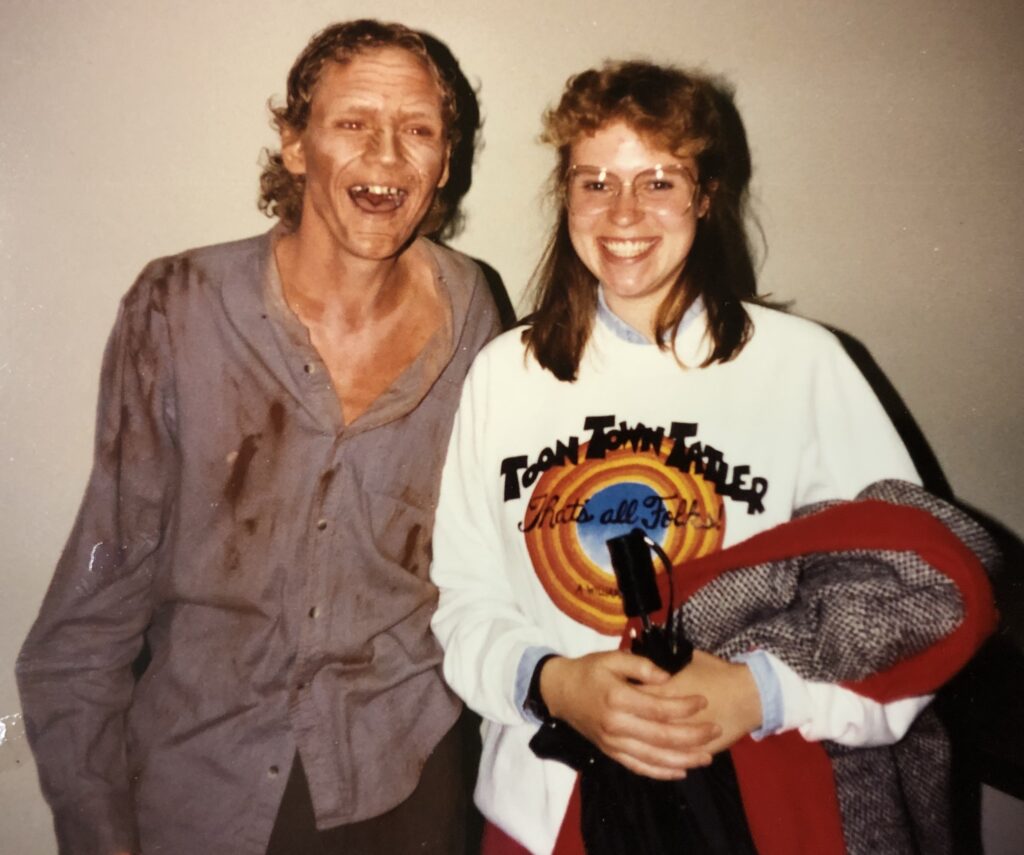
I acted in more plays in my senior year of college. I was hooked on acting and performing on the stage. My dad would have hated to hear this when he was paying my college tuition. However, if I could do my college years over, I probably would have majored in communications, theater, or acting. I loved being in front of an audience, especially to entertain or just inspire people.
During my senior year of college, I participated in a program where a recent William Jewell graduate mentored me. I was clueless what job I wanted after graduation. However, I knew I loved public speaking and my dream job was to be a traveling public speaker. Thus, this mentor program matched me with a recent alumnus who worked for Fred Pryor Seminars.
This mentor met with me several times and invited me to a Fred Pryor Seminar for free. The speaker at this seminar taught about the value and basics of speed reading. The seminar was enlightening. The speaker was entertaining, educational, and captivating, especially with his stories of famous people who used speed reading to succeed in their careers. At that time, leading a Fred Pryor seminar seemed like an ideal job for me. However, I needed to gain some experience before Fred Pryor would consider hiring me. Unfortunately, I was graduating from college in a few weeks, and I had no career plan how I could get hired by Fred Pryor.
Working at Crater Lake National Park during the summers
In May 1992, I graduated from William Jewell College with my degree in Business Administration. I had no idea what to do with that business degree. I still don’t! While I was in college, I was recruited by an organization called A Christian Ministry in the National Parks (ACMNP). They recruit college students to work jobs for the concession companies in the national parks. The catch was that these college students would then lead the ACMNP interdenominational church services on Sunday mornings. In high school and college, I gave in and became religious since my parents and sisters regularly went to church. I figured volunteering with ACMNP in a national park gave me a chance to do regular public speaking, since I would be leading and preaching during these church services.
ACMNP found a job for me working at the Crater Lake National Park at the Rim Village gift store. I had never seen southern Oregon, so this would be a new adventure for me. I had always loved snow covered mountains and tall pine trees. My high school symphonic band played for the Expo 86 World’s Fair in Vancouver, Canada in May 1986. During that trip, I fell in love with the beauty of the Pacific Northwest. My goal was to someday escape the Midwest and live the in Pacific Northwest. Thus, it was a dream come true to spend a summer working at Crater Lake.
When I arrived at Crater Lake Rim Village, the scenery did not disappoint. Crater Lake was one of the most spectacular sights I saw in my life. The lake was 6 miles across at its widest point with this deep cobalt blue color. The rim mountains that surrounded it were decorated with snow, looking like an amazing cake decoration with the white icing on top. The pine trees were so tall, unlike the much smaller deciduous or leaf producing trees in my home state of Missouri. It was so quiet standing on the rim admiring the lake, except for the very light whistle of the wind and an occasional airplane flying overhead.
My first Crater Lake summer was magical. I enjoyed my job working as a stock clerk at the huge Crater Lake Gift Store at Rim Village. I found friends to go hiking with me to help me explore every scenic trail in the park that summer. If no one was available, I happily hiked on my own.
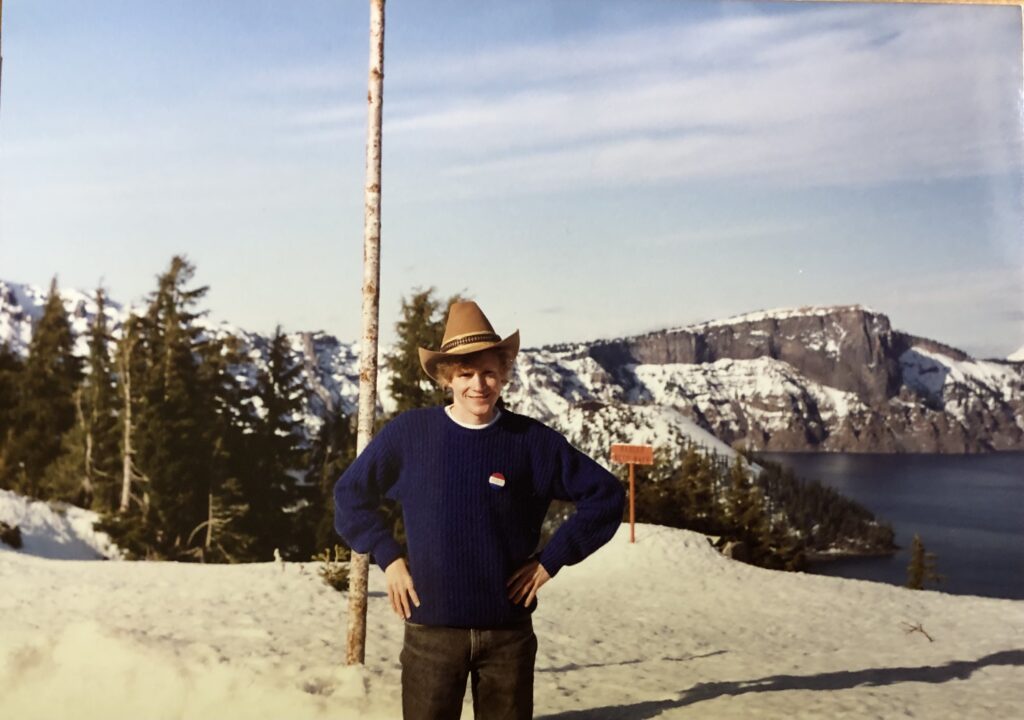
I enjoyed leading the church services at the campground amphitheater during my first three summers at Crater Lake National Park. It was fun to be in front of an audience and to prepare those brief sermons. It was a different audience of campers every weekend. Thus, I could recycle the same sermons and use them repeatedly.
In the summers of 1993 and 1994, I worked as a gift store lead clerk. In 1995, the General Manager of the Crater Lake Company asked me to work as the night auditor at the newly rehabilitated Crater Lake Lodge, which reopened that year. I soon discovered working all night and sleeping through the daytime splendor of Crater Lake was not my cup of tea. In 1996, the National Park Service (NPS) hired me to be an entrance station fee collection ranger at Crater Lake. I enjoyed this job, except for the occasional angry visitors who were upset when I charged them the then $5 entrance fee that to enter Crater Lake National Park.
I worked this ranger job the following summer in 1997. Around that time, NPS changed the job title to Visitor Use Assistant (VUA). I didn’t care what they called me. I just loved wearing the ranger uniform, as well as living and working at Crater Lake. I did not become financially rich working at Crater Lake, but my life experience seemed so incredibly rich working there.
Discovering Climate Change while working the winters in Everglades National Park
Crater Lake was a summer seasonal job, so I had to find a different national park to work during the winter. Thus, I started working in Everglades National Park during the winters in December 1992. The Everglades could not have been more different than Crater Lake. Unlike Crater Lake, the Everglades had no majestic snow-capped mountains or one of the cleanest and bluest lakes in the world. The Everglades was just flat, and the water looked rather murky, especially in the backcountry mangrove canals and in Florida Bay.
I relished the unique wildlife I saw, such as alligators, crocodiles, dolphins, manatees, and the wide variety of birds. The canoeing in the Everglades was a fabulous experience. My high point was the overnight canoe trip with friends to Alligator Creek and Florida Bay in February 1993.
During the winter of 1999, I saw a flock of wild Flamingos standing in the shallow waters of Snake Bight when I canoed to that area in Florida Bay. There must have been 50 to 60 in this flock. They stood around 4 feet tall. You could not get too close to them. However, when I did, it was breathtaking to see them take off in flight. They had to awkwardly run across the water for a bit to take off on a runway like an airplane. Then they would fly exposing their long black wings, which sharply contrasted the light pink feathers on the rest of their body, neck and head.

The Everglades then became my winter home. My first winter, 1992-93, my first job was in housekeeping for the Flamingo Lodge. I then transferred to a Front Desk Clerk Position. In the winter of 1995-96, I worked as a night auditor at the Flamingo Lodge.
In 1998, I started giving ranger talks in Everglades National Park. Visitors then asked me about this global warming thing, which I knew nothing. Visitors hate when park rangers tell you, “I don’t know.” Visitors expect park rangers to know everything. Don’t you?
Soon afterwards, I rushed to the nearest Miami bookstore and to the park library to read all I the scientific books I could find on climate change.
The information I learned scared me, specifically sea level rise along our mangrove coastline in Everglades National Park. Sea level rose 8 inches in the 20th century, four times more than it had risen in previous centuries for the past three thousand years. Because of climate change, sea level is now expected to rise at least three feet in the Everglades by the end of the 21st century. The sea would swallow up most of the park and nearby Miami since the highest point of the park road less than three feet above sea level.
It shocked me that crocodiles, alligators, and Flamingos I enjoyed seeing in the Everglades could all lose this ideal coastal habitat because of sea level rise enhanced by climate change.
I became so worried about climate change that I quit my winter job in Everglades National Park in 2008. I started spending my winters in my hometown of St. Louis Missouri to find some way to organize for climate action. Up until 2017, I still worked my summer job Crater Lake National Park. I loved the incredible beauty there and wearing the ranger uniform with pride while engaging with park visitors. I had a hazy plan to give public speeches and create greater climate awareness during my winters in St. Louis.
Becoming ‘The Climate Change Comedian’ to promote myself as a climate change speaker
During the summer of 2009 while I worked as a seasonal park ranger at Crater Lake National Park, I became lifelong friends with fellow seasonal park rangers Graham Hetland and Aubrey Shaw. They lived permanently in Ashland, Oregon where they attended Southern Oregon University at the time. Graham’s mother lived in Ashland, and they needed to find someone to housesit for his mom, Barbara, for the winter. Barbara planned to go on a cross country road trip in a RV. Thus, they needed someone to watch her home and her friendly cat, Poppy. I planned to return to St. Louis, but they persuaded me to housesit for their mom.
I moved from Crater Lake to Ashland, Oregon in October 2009. Ashland, Oregon is a beautiful small city in southern Oregon nestled right against the Siskiyou Mountains. The leaves turned brilliant autumn colors while I was there. The weather had ideal Indian summer days while slowly getting cooler as the calendar immersed into fall. It was fun to walk around Ashland for exercise and take pictures of Ashland experiencing autumn. At the same time, I found myself restless. I wanted to pursue my climate change calling, but not knowing what to do about it.
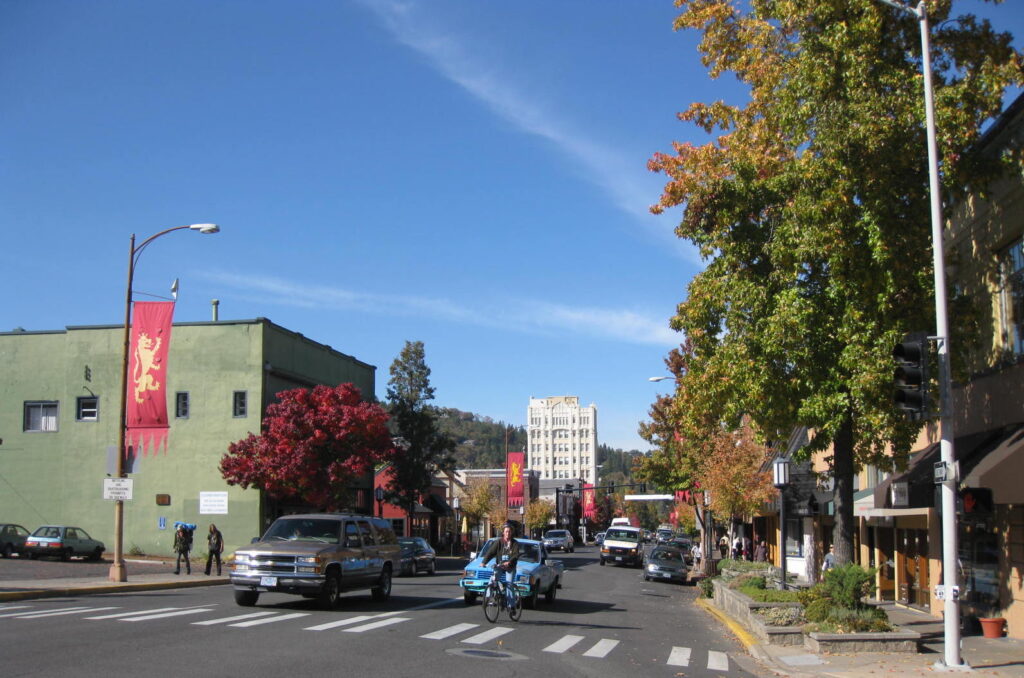
One day, I visited my friend Naomi Eklund who lived in Ashland, Oregon then. She was pressing me on what exactly did I want to do with my life. She kept pushing me harder. Finally, I snapped, “Fine! If I could do anything, I would like to be ‘The Climate Change Comedian!”
Naomi was a tough audience, but she nearly fell out of her fell out of her chair laughing. She responded: ‘That’s perfect! I want you to go home and grab that website domain name now, www.climatechangecomedian.com.’
I went home and did that. Barbara soon sent news that she did not like RVing across country. She decided to return to her home where I was housesitting in Ashland. Around Thanksgiving, Barbara announced that she did not want to share her home with me. My parents just moved into a new home in St. Louis,. They wanted me to return home to spend the winter with them.
In mid-December, I then drove from Ashland Oregon to St. Louis, Missouri. I stopped in Flagstaff, Arizona to visit friends in who worked in Grand Canyon National Park. They talked me into hiking solo to the bottom of the Grand Canyon on a two-day backpacking trip, one of the best experiences of my life. I then raced to arrive in St. Louis late in the evening on Christmas Eve to spend the Holidays with my family.
During that winter in St. Louis, Naomi advised me to fully develop my website and create my own climate change PowerPoint that I would use for my presentations. Early in 2010, I developed my first climate change PowerPoint, “Let’s Have Fun Getting Serious about Climate Change.” I showed that PowerPoint to friends and family in the St. Louis area. A family friend helped me launch my www.climatechangecomedian.com website that is still active to this day.
State #1: My first climate change talks in Missouri in 2010
During the early months of 2010, my sisters in St. Louis wanted me to speak at my nieces’ and nephews’ schools. My younger sister first booked me to speak at my nephew Sam’s second grade class in St. Charles, Missouri on February 5, 2010. This was my first presentation outside of working as a ranger in the national parks.
For this presentation, I brought my inflatable Earth Ball, which is my symbol for caring and appreciating our planet. I used an Earth Ball for years in my Everglades and Crater Lake ranger talks. The symbol of me holding an Earth Ball is the image I use for my website and all the social media platforms I use (Facebook, Twitter, and LinkedIn). The young students liked seeing the inflatable Earth during my talk.
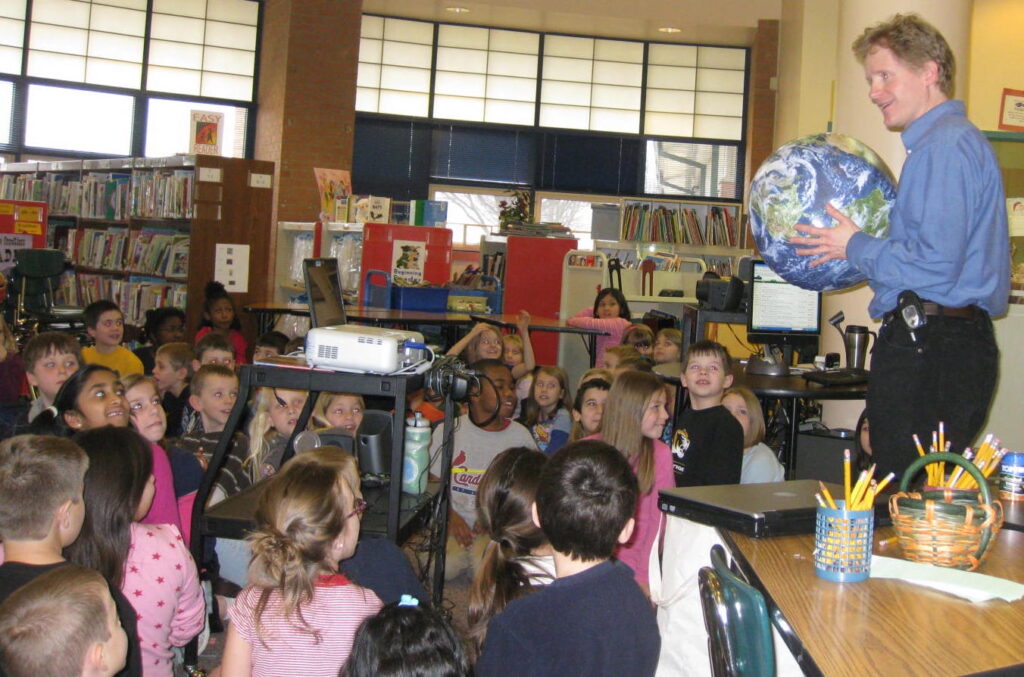
I aimed to keep my talk kid friendly by focusing on the animals I saw working in the national parks, such as alligators, crocodiles, dolphins and birds, such as Bald Eagles, Woodstorks, Mangrove Cuckoos, and Gray Jays. I just stressed the general importance of taking good care of our national parks. The title of this talk was “It’s Your World to Discover and Protect.”
To attempt to make this program relatable to my audience, during the program I had an image of my nephew Sam and his height at the time of almost 4 feet tall. I compared Sam’s height to the height of the Gateway Arch, 630 feet tall, which is also a national park. It’s now known as Gateway Arch National Park in downtown St. Louis, Missouri. I showed the kids that you would have to stack up 157 Sams to create the same height as the Gateway Arch.
I then talked about Crater Lake as the deepest lake in the U.S. at 1,943 feet deep. One could stack 3 Gateway Arches in Crater Lake and still have 42 feet of water covering the highest stacked Arch or 483 Sams stacked vertically on top of each other. After the presentation, my nephew Sam came up to me in the most adorable way and said, “You embarrassed me.”
I apologized that I did not intend to embarrass him in front of his classmates. He seemed to forget it and he was ok. I doubt that was the worst thing that ever happened to him in school.
Exactly one month later, March 5, 2010, I gave a similar program to oldest niece and goddaughter Rachel’s seventh grade class in St. Louis. I used the same title, “It’s Your World to Discover and Protect.” Like the program at Sam’s school, I had a picture of Rachel in my talk and how she was 5 foot 2 inches tall at that time. I showed that 122 Rachels stacked vertically on top of each other would be the same height as the Gateway Arch. Or, 376 Rachels stacked vertically on top of each other would be the same height as Crater Lake. I thought the teachers introduced me before the talk as Rachel’s uncle or I assumed Rachel’s teachers and classmates knew I was her uncle. However, when I finished my talk, Rachel raised her hand to say, “Could you please tell them how you are related to me? None of these students seem to know about that.”
Like my previous talk, I ended this talk with a 25-foot Mentos and Coke fountain demonstration. This talk was a breakthrough for me because this was the first time I talked about climate change in a public talk. I showed that the average annual snowpack had gone down over the last several decades at Crater Lake. I defined global warming as humans trapping more carbon dioxide and greenhouse gases in our atmosphere. As a result, the average temperature of the planet has increased since the Industrial Revolution started in 1880.
On month earlier, in February, Rachel and Andrew came to my parents’ house for the day. They brought with them their individual blue Snuggie blankets that you wear like a robe to lounge around the house on a cold winter’s day. I took pictures of Rachel and Andrew without their Snuggie blankets sitting comfortably, pretending to be freezing without their Snuggie blankets, sitting comfortably with their snuggie blankets, and then I piled more blankets on top of them while their expressions turned angrier and sadder. I used those pictures to demonstrate the earth without greenhouse gases (both pretending to be freezing), the earth with greenhouse gases (both of them enjoying wearing their Snuggie blankets indoors on a cold winter’s day), and then piling blankets on them to demonstrate more greenhouse gases trapping heat causing climate change. I loved showing these pictures in climate change talks I gave to kids.
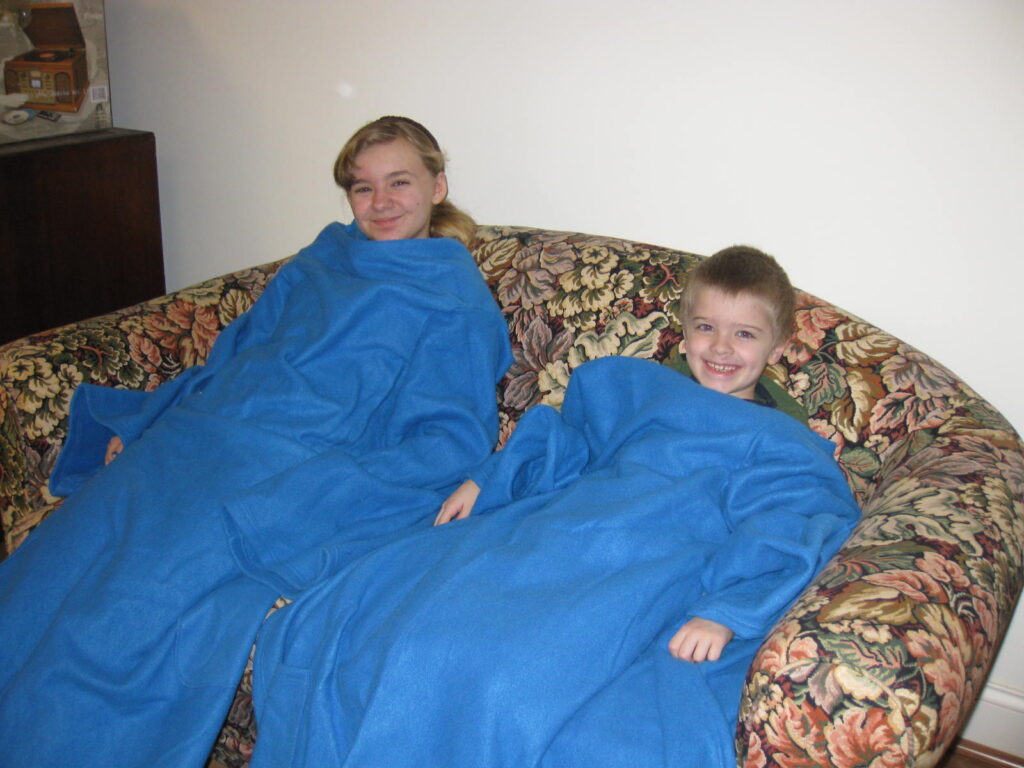
At my March presentation at Rachel’s school, I then talked about how climate change could cause problems with less snowpack, greater heat waves, and sea level rise. I then urged them to reduce the threat of climate change by recycling, unplugging voltage vampire appliances in their homes, and turning down the heat by putting on a sweater or snuggle blanket. Hopefully, this message on climate change somehow planted a seed in the minds with these students. I will always be grateful that my older sister, my oldest niece, her classmates and school gave me an opportunity to talk about climate change for the first time in a public talk.
At Crater Lake National Park that summer, I gave my climate change PowerPoint informally to some of my ranger friends one evening and I shared it with a few other ranger friends. During my cross-country drive from Crater Lake National Park, Oregon to St. Louis, Missouri in November 2010, I showed this PowerPoint twice. I shared it to some ranger friends in Page, Arizona and to my college friend Brent in Oklahoma City, Oklahoma. These friends gave me some helpful tips and feedback to improve my talk.
Joining South County Toastmasters St. Louis, Missouri in January 2011
To improve my skills as a public speaker and climate change communicator, I joined a local Toastmasters group, South County Toastmasters, in January 2011. When I submitted the application to join Toastmasters, the tradition is that a club member with the position of the sergeant-in-arms escorts the visitors and applicants requesting to join out of the room. This allowed the existing members to candidly discuss and vote to approve the new members. While I waited in a different area, I could hear the members laugh when the Club President read my application that I was joining Toastmasters “to be a better climate change communicator.” Up to a third of this Toastmasters Club were conservative climate change deniers. Thus, this would be a tough audience to give climate change talks. It was exactly what I needed to improve.
On February 16, 2011, I gave my introductory speech to South County Toastmasters called, “I Would Rather be Here than in Paradise.” My first Toastmasters speech turned out to be a weird experience. I asked a fellow club member to video my speech using my digital camera. Sadly, I did not have an enough available space to record the speech on the camera’s SD card. The other pictures and videos on it took up too much room. Thus, I did not get all the speech recorded. However, I was able to get my introduction by club member George Kiser on video, as well as a couple of minutes of my speech. Later, I uploaded it to YouTube to document this occasion.
This was one of the few Toastmasters speeches that I did not turn the text of the speech into a blog. Therefore, I will include it here:
My icebreaker Toastmasters Speech: “I would rather be here than Paradise”
“’The only courage you need in your life is the courage to follow your dream.‘
I heard Oprah Winfrey say this on her show eight years ago. I am here tonight giving my icebreaker at South County Toastmasters because I am taking the courage to follow my dream in life. Following my dream led me to some strange twists: from leaving the Florida Everglades, to currently visiting St. Louis, and to eventually returning to Crater Lake. The first twist you will think is odd and crazy.
I gave up a dream job as a winter ranger in Everglades National Park in Florida to be with you here tonight. What? Does that sound crazy? Today, in south Florida it was sunny with a high of 78 degrees. Compare that to the snowy and icy weather in St. Louis this past month. Raise your hand if you would rather be in sunny, warm south Florida this winter than St. Louis?
For ten years, during the winter I was a naturalist park ranger in the Everglades. I wish I had a dollar for every person, even from some of you in this room, who told me they would love to be a park ranger. As an Everglades ranger, I lead canoe trips to show people dolphins, alligators, birds, and manatees. I also presented ranger talks about the birds and history of the Everglades. If you love public speaking and nature, I had the perfect job and I loved it. So, why on earth, as crazy as it sounds, would I walk away from the perfect job three winters ago?
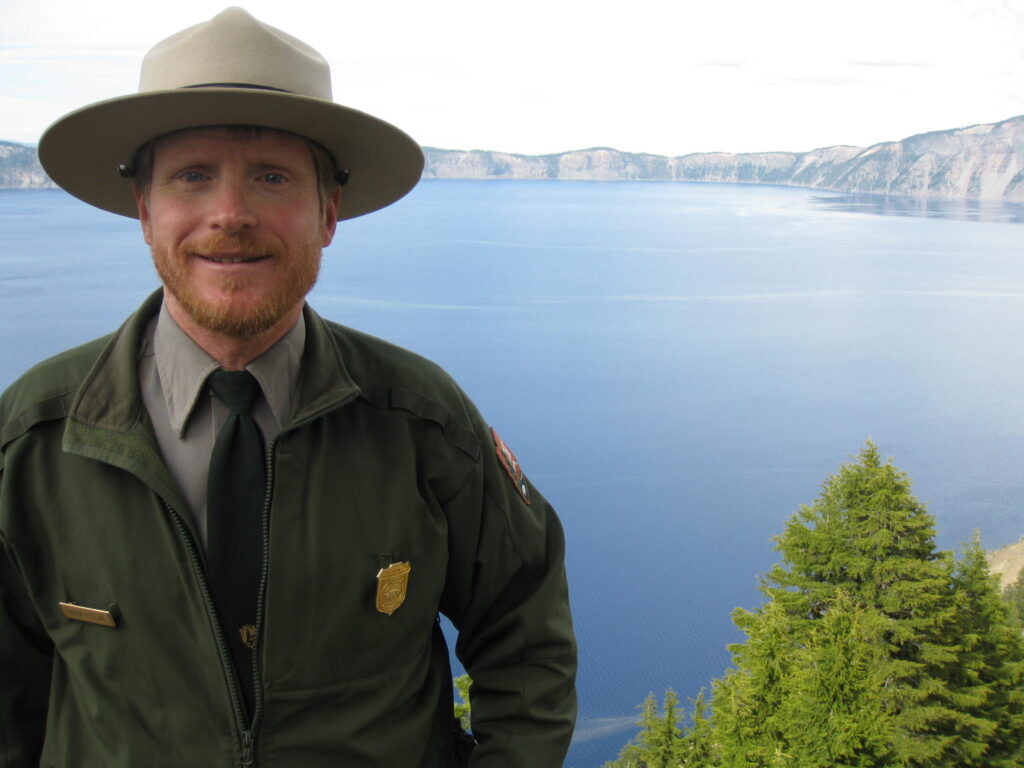
Two words: CLIMATE CHANGE
Over twelve years ago, visitors started asking me how climate change was affecting the Everglades. People expect park rangers to know everything. Thus, I added climate change to my reading list so I can be the all-knowing park ranger. However, the more I read about climate change, the more alarmed I became. In November 2007, while I was still working in the Everglades, I decided to dedicate the rest of my life to the issue of climate change. Now I want to use my skills I gained as a public speaker as a park ranger to humorously educate and inspire people, like you, to take action to resolve climate change.
In May 2008, with the courage to follow my dream, I said goodbye to the Everglades. I have not looked back. It is three years later, and I am still working on my life’s mission. Last winter in St. Louis, I developed my own humorous power point on climate change, entitled “Lets Have fun Getting Serious about Resolving Climate.”
I developed my own website that I am still building www.climatechangecomedian.com (…Oops! Kevin, are we allowed to plug our own personal ventures during our Toastmasters speech?)
Anyway, the goal of my website will be to humorously promote me as a speaker who will entertain, educate and inspire people on the problem and solutions to climate change. I hope to talk to any group willing to listen to me: such as students of all ages, seniors, church groups, business groups, dentists, lawyers, IRS agents, Hells Angels, and whoever else wants to join my dream to make this a healthier planet.
I want to start this conversation on climate change with you and my hometown of St. Louis. I was born and raised here. When I am working in the national parks, I miss the Cardinals, Imo’s Pizza, Ted Drewes, Chuck Berry, my family, and what else am I missing?
Why the Arch of course!
However, there is one thing about St. Louis that I will never like? Any guesses:
(Pause)
THE SUMMERTIME HEAT AND HUMIDITY. I have not spent a summer here in 18 years, and I cannot stomach the thought of spending this summer here either.
Thus, I have not totally given up my day job as a ranger. For the past 18 years, I have spent my summers as a naturalist ranger in Crater Lake National Park in Oregon. From May to October, I narrate the boat tours, guide sunset ranger hikes, provide geology and history talks, and present an evening campfire program. Even better is the summertime weather at Crater Lake. Since the park is in the mountains, a normal summer temperature is around 67°F with very low humidity. So, in July and August, I would rather be in Paradise than here.
Fellow Missourian, Mark Twain once said, “You should live your life so fully, so that when you die even the undertaker will be sad.”
For years, I had the dream to be a national park ranger. Now I am taking the courage to follow my dream to humorously educate people about climate change, starting in St. Louis. I appreciate you, fellow toastmasters and honored guests, allowing me to share my dream with you in my icebreaker here tonight. Mr. Toastmaster.”
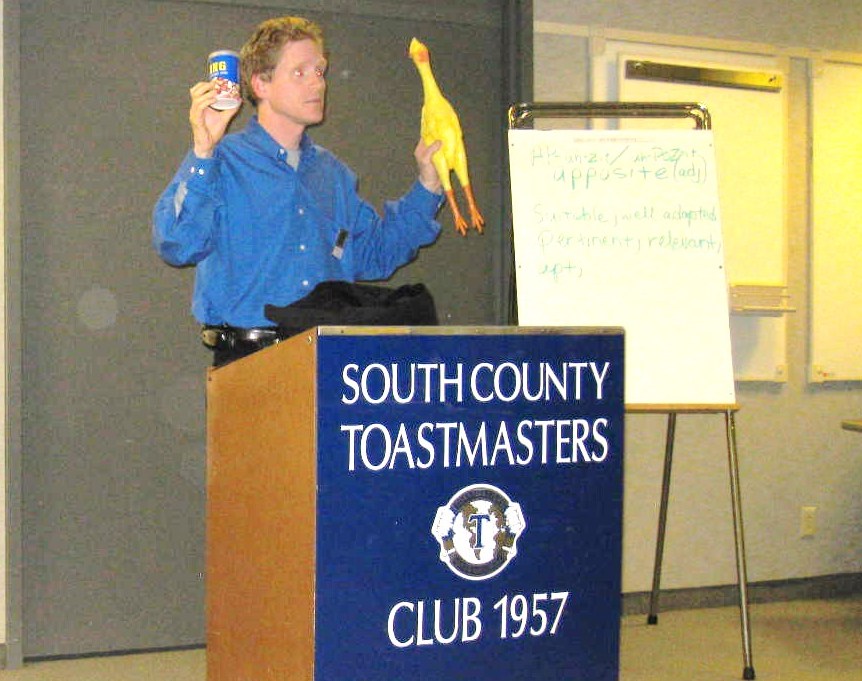
My second speech for South County Toastmasters in April 2011
After my speech was completed, the club had an evaluator assess my speech. Each Toastmasters speech is assigned an evaluator, which is a fellow club member. The Evaluator gives a short speech to the club what they liked about my speech and my areas for improvement.
I was exhausted after giving this speech. Like anything I do, I put it all out on the court with nothing left. My evaluator said that I looked at my notes too much since this is my life’s story. It’s me. I should not need any notes to tell it. I thought that was good advice to not rely upon notes and have the speech memorized to make a more authentic connection with the audience.
After the speech, it was announced that some of the members were going to a nearby restaurant to hang out and chat. My parents came to see my Icebreakers speech. My mom planned to go home and go to be early, like she normally does. My dad wanted to go to this social event. I just intended to go home. However, since my dad wanted to go hang out with the Toastmasters, I grudgingly went along with him. I sat by some of the Toastmasters at the far end of the table. I felt spent after giving that speech.
However, two of the members, Adam and Dee, made their feelings very plain to me that they were conservatives, and they did not ‘believe in global warming.’ Adam loyally listened to FOX Business News and Dee loved listening to Rush Limbaugh. They wanted to lecture me how I was wrong. They were irritating me more by the minute. Dee decided to give me an ear full that I needed to listen to the people on the other side who did not agree with me.
I finally had enough. I gently took her by the arm and hand. I look her fully in the eyes. I kindly but firmly said, “Dee, I have already listened to people on the other side. Their positions are simply wrong. They have no evidence to back up their claims.”
She did not like that I was holding her arm and hand as I pushed back on what she said. She retorted, “Stop treating me like an old woman!”
I didn’t say anything more. I bit my tongue. Internally, I wanted to say, ‘Stop acting like an old woman! You are not used to someone standing up to you. However, I am going to stand up to you when I think you are wrong, and you are wrong right now.’
It would have thrown gasoline on the fire to say that. My speech was an Icebreaker. That’s it. However, Dee and Adam wanted to hear the key evidence for climate change in a future speech.
Right there, they gave me an idea for my next speech. Even though I was ticked off in this interaction with them, they had laid down the challenge for me for my next speech.
I decided if I was going to go for it to talk about the key evidence for climate change, I was really going to for it. In a sense, this speech would be like passing a very loud and smelly fart at a fancy cocktail party.
To address the uncomfortable elephant in the room, I called my second Toastmasters speech, “I am going to drop a stink bomb on you!” One of my friends that I practiced my speech with was fellow Toastmaster, Nilsa Scott. She thought my speech title and concept for my speech was hilarious. I practiced this speech many times with my Nisla, my Toastmasters mentor Rob Van Winkle, my godmother Jeanette Dantico, and my parents.
This speech did not go as well as I hoped. My Toastmaster evaluator pointed out that I had trouble with the Club’s remote control to change my slides. Therefore, he recommended that I get my own remote control to be more fluid to advance the slides. In addition, he did not like that I turned my back to the audience to point out specific items on my PowerPoint. He advised me to buy a remote control with a laser pointer and to not turn my back on the audience. Although I did not feel like my speech delivery went smoothly, I thought the evaluator gave good advice.
The good news was that I was voted as “The Most Improved Speaker.” At the same time, this was the second speech where I was not voted as the best speaker. I was determined to stick with Toastmasters until one of my speeches was voted on by the Club as “The Best Speaker.”
Unfortunately, I did not get a video from this speech. However, I did turn the text of that speech into a blog later that year.
I made plans to leave St. Louis in late May to head back to Crater Lake National Park for the summer. Thus, I was determined to give one more speech and to do what I could to make the third speech ‘a winner.’ I was going to make the third speech the charm.
My third and winning Toastmasters speech in May 2011
Since the stink bomb speech was serious and technical about climate change, I decided to go lighter for my next speech in May 2011. It was called “Time to Say Goodbye.” This speech was about saying farewell to my temporary job at the St. Louis Science Center’s climate change exhibit, saying goodbye to my fellow Toastmasters as I was leaving St. Louis to return my summer seasonal ranger job at Crater Lake National Park, and my dream of saying goodbye to my ranger job so I could work full time on climate change communications and organizing.
Like my previous speech, I practiced very hard on this speech with Nilsa, Rob Van Winkle, my godmother, Jeanette Dantico and my parents. Unfortunately, my parents were out of town on a vacation trip, so they were not able to see this speech. It was a shame. I wish they could have been there because I was voted as “Best Speaker” for this speech. Yes! I finally was voted “Best Speaker” by my Toastmaster peers. I felt elated! I was leaving for Oregon on a high note.
I uploaded to YouTube a partial video of this speech. Sadly, this time, the beginning was cut off. The person who I asked to film me forgot to turn on the video at the beginning of my speech. Like the first speech, I was glad I got a partial video at least to document this speech.
Similar to my first Toastmasters speech, I forgot to turn that speech into a blog. Thus, I will include the text of that speech here:
Time to say goodbye!
“It’s time to say goodbye. That’s the goal of this speech is to get right to the point! That’s what I am going to do my speech tonight: Say goodbye to my present job, to you and to my present career.
First of all: I wanted to say unlike my previous speeches I am saying goodbye to PowerPoint, tonight only, so I can speak directly to you and not hide behind any technology. So for tonight only, it’s goodbye PowerPoint, and hello fellow toastmasters!
Next, I must say goodbye to my present job. As you may recall, when I joined Toastmasters in January, I was unemployed and struggling to find my calling to educate people about climate change. Well, in mid-March, I got a job at the St. Louis Science Center engaging visitors and answering questions at their temporary climate change exhibit. Over the past two months, I absolutely loved this job. It was a dream come true to be able to talk about climate change all day and be surrounded by the detailed science posted in the displays throughout the exhibit. I also loved my boss and co-workers and I chatted with so many adults and school groups around the St. Louis area who were accepting or critical of the concept of climate change. Their positive or negative opinions did not bother me.
I just relished being able to talk about climate change all day at work. I did literally feel like a kid in a candy store. Unfortunately, I have to say goodbye to this job on Sunday, May 15th. That is when this temporary exhibit ends and moves on to Cleveland in mid July. I hope you are can stop by the exhibit when I am working on Friday or Saturday before St. Louis says goodbye to it on Monday. This goodbye will be sad because how much I loved this job and how much it connected to my passion to inspire people to resolve climate change.
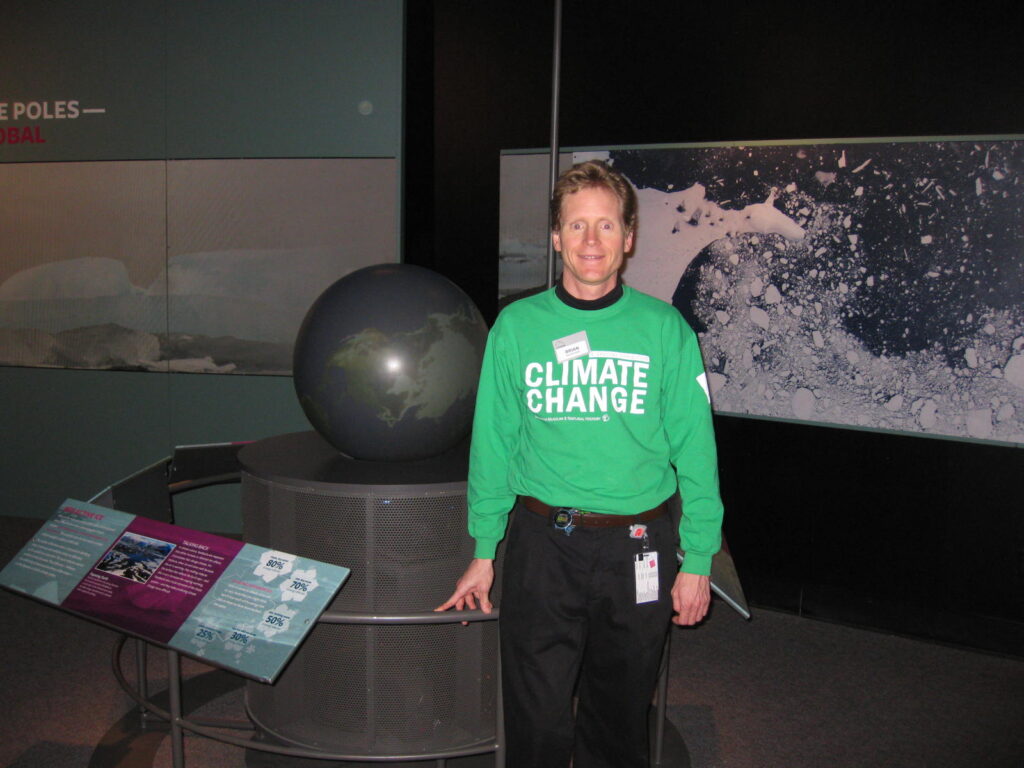
Next, I must say goodbye to you guys. You were all so welcoming when I joined in January. I made so many good friends and all of you were so helpful in critiquing my speeches. I think I will be able to make it to the next two meetings. However, I will miss you guys as I say goodbye to you and my hometown of St. Louis and head to my summer job at Crater Lake. So, if you are not able to make it to the next two meetings it will be time to say goodbye tonight.
Where am I going to is to my summer and spiritual home of Crater Lake National Park in Oregon. I am a naturalist ranger there leading various presentations, such as the boat tours, trolley tours, geology talk, sunset guided hike, evening program, etc. You all are more than welcome to come to my programs. You can count and tell me how many ahs and ums I accidently use during my ranger talks.
As I have hinted before, after nearly two decades, it may be time for me to say goodbye to Crater Lake also. I am getting tired of being a seasonal ranger. The moving and isolation in the national parks has reached its limits for me. Also, I really want to pursue my passion about educating, entertaining, and inspiring people about climate change as a public speaker. Thus, it may be time for me to really say goodbye to Crater Lake.
Also I have personally witnessed the effects of climate change while working in the national parks. When I worked in the Everglades, I saw the marine bays getting saltier and saltier with more erosion happening with sea level rise. At Crater Lake, I have personally seen our annual snowpack diminish over many years. Just like in Colorado, I have seen mountain pine beetles destroying our lodge pole pine trees. The beetles are surviving increasingly mild winters and having quite a party with our lodge pole pine trees and whitebark pine trees. With all these signs of climate change, I feel like I can no longer be the happy ranger just entertaining people in national parks. I feel called to say goodbye to Crater Lake and take this message to the cities.
Before I say goodbye to my current job, you and Crater Lake, I want to leave you with a gift. In one of my ranger programs, a guided sunset hike, I end the program with a collect of wisdom that I gained from all my years of spending time in nature and observing the park visitors. Somehow, I doubt you will be able to join me on my hike. So, if you flip over the paper, I am going to share and even let you keep:
RANGER BRIAN’S WISDOM
Would ___________ read the first three lines:
For Every Question,
There Is Not Necessarily an Answer.
Yield to the Mysteries of Nature.
Would ___________ read the second three lines:
Take Time to Enjoy the View
and Smell the Roses.
Find your Own Sacred Place
Would ___________ read the third three lines:
If Nature is Your Hobby,
You Will Never Be Bored.
You Can Never Step in the Same Stream Twice
Would _____________ read the fourth three lines:
There Are Things We Love, Things We Hate,
And Things to Which We are Indifferent.
However, In Nature, Everything Matters.
Would _______________ read the final three lines:
Every Single Person Makes the World
Every Single Day.
Think Globally, Act Daily.
I hope you have a wonderful summer here in St. Louis. Be thinking of me when you enjoy that Ted Drewes or Imo’s Pizza or other local amazing Italian food or go to a Cardinal’s game. I will be missing these luxury items in my mountain paradise home. Anyway, Mr. Toastmaster, fellow toastmasters and distinguished guests, it’s time once more for me to get to the point and close by saying: IT’S TIME FOR ME TO SAY GOODBYE!
Mr. Toastmaster.”
I could write a lot more about my Toastmasters experiences, especially with giving climate change talks. I will stop though because it is covered in a separate blog from 2016, Want to be effective on climate change? Join a Toastmaster group.

State #2: My first climate change talks at Crater Lake National Park, Oregon in 2011
As I witnessed from my Toastmasters group, giving climate change talks can be brutal. You never know if you will have climate change deniers in the audience who will make the speech or your interaction with them afterwards very uncomfortable. I initially learned about climate change working in Everglades National Park in 1998. By 2008, I wanted to do something about it. For years, I feared giving a ranger program in the national parks focused on climate change because I worried about conservative visitors would want to get in a fierce argument about it.
I first mentioned in 2008 to my superiors at Crater Lake that I wanted to give a ranger program about climate change. My Crater Lake supervisor, Eric Anderson, and the lead interpretive ranger, David Grimes, were supportive and encouraging of my idea. I just did not feel like I knew enough or was brave enough to do such a program. Finally, in 2011, I felt that I was ready. I had been doing my evening program centered on the birds of Crater Lake for five years. I enjoyed giving that program, but I was motivated to transition my evening program to climate change. David Grimes helped me with the information and images about climate change that he had wrote about for years in the park newspaper. I used the PowerPoint graphs and information I received from the park scientists that they had shared with the ranger staff during training.
Working as an interpretive park ranger at Crater Lake is a full-time job of giving programs such as boat tours, trolley tours, lodge talks, geology talks, step on tours, guided hikes, and working at the visitor center desk answering questions. Engaging with visitors and working outside in the sun all day was exhausting, even if I loved my job and put 110% effort into it. Thus, I came home in the evenings from work flat out tired. Yet, I was motivated to create an evening program on climate change.
After months I of putting it together in my spare time, I debuted my climate change evening program at campground amphitheater on August 3, 2011. The program went extremely well. To my surprise, the audience responded very positive to my program. As a matter of fact, the park visitors really seemed to like it as I gave it numerous times over the next 6 summers.
I blogged about my Crater Lake climate change evening program elsewhere. I was always very proud of this program. Even more, I was delighted when the lead interpretive ranger, David Grimes, videotaped the program on September 22, 2012, so that I could upload it to YouTube. It’s not easy to travel to Crater Lake. Furthermore, I stopped working at Crater Lake in 2017. Therefore, it is great to have this program on YouTube so that you can watch it.
State # 3 Virginia: Speaking at the NAI Conference in Hampton, Virginia in 2012
In June 2008, National Park Service ranger John Morris from Alaska came to Crater Lake to attend our annual ranger interpretation training. One evening, he gave a sample climate change program how climate change impact our national parks. He had great humor in this program, even showing an image of the ultimate proof of global warming. It was a change in the underwear fashion over the decades. John chuckled as he showed that image and the audience laughed at that comical image. John was the first person to show me that one could have fun giving a climate change talk while educating the public the seriousness of the issue. I knew then that I wanted to be like John and give climate change talks like he did that evening.
I stayed in touch with John afterwards to see if he could advise me. In 2011, he suggested that I apply to the Earth-to-Sky V Training that would be held in Shepherdstown, West Virginia on September 26 – 30, 2011. During the summer of 2011, I did apply for that training and was invited to attend. Earth-to-Sky is a partnership between the National Aeronautics and Space Administration (NASA), the National Park Service (NPS) and the US Fish and Wildlife Service (USFWS).
Earth-to-Sky offers training conferences where NASA scientists share their research about climate change, how Earth systems operates, and astronomy. The NASA scientists and the conference facilitators from NPS and the USFWS give climate change information and communication tools to help NPS interpretive rangers, USFWS educators, and government scientists to better educate the public about climate change. Earth-to-Sky V Training focused exclusively on climate change. The information provided by the NASA and other government scientists about climate change was extremely valuable to me. They challenged each of us at the training to come up with a solid action plan how we would implement the information they provided us about climate change and how to engage the public about it.
My action plan was to create a Crater Lake climate change park handout, which I completed in 2012. In addition, I would petition my supervisor to include a climate change training for the ranger naturalist staff that I would lead during seasonal training. My supervisor approved of this idea. As a result, I gave a climate change hour long training to the park staff from 2012 to 2019. In 2018 and 2019, I returned to Crater Lake to lead this training, even though I no longer worked there. That felt like a big honor for me to be invited return to Crater Lake to give this climate change training, even though I stopped working there.
It felt like that 2011 Earth-to-Sky V Training was like a gift that kept giving. It helped advance me as a climate change communicator. I wanted to give back to the Earth-to-Sky partnership somehow. Through John Morris and other Earth-to-Sky facilitators I met in Shepherdstown, I learned that Earth-to-Sky would give a climate change seminar before the NAI (National Association for Interpretion) Conference in Hampton, Virginia in November 2012.
I applied to be a speaker at this breakout training, and I was accepted. This was my first business trip traveling to a different part of the U. S. to give a climate change talk. NASA paid for my lodging, rental car, and airfare to speak at this conference. I felt like a true business trip as a professional speaker. It reminded me of when I went to see the paid professional speaker at the Fred Pryor Seminar weeks before my college graduation in 1992. When I saw that speaker, my thought was: ‘I want to be a professional speaker someday for something I had a passion.’
Around 20 attendees, including me, participated in this Earth-to-Sky seminar before the start of the NAI conference. Earth-to-Sky brought a couple of NASA scientists who were terrific speakers to explain the basics of climate change. I gave my talk towards the end of the conference. The title of my talk was “Pump You Up to Talk about Climate Change.”
My theme was the specific things that inspired me to give climate change ranger talks in the national parks. I focused on five specific items that inspired me:
• The location of working in the national parks
• Knowledgeable: Visitors expected me to know information on this subject – similar to how they expect rangers to be fluent in all subjects relating to a national park they are visiting,
• Passion: From my knowledge came a passion for the subject of climate change.
• Peer pressure: some of my ranger colleagues at Crater Lake and other parks were already giving climate change talks.
• Courage: After interviewing the Crater Lake scientists how climate change impacted Crater Lake, borrowing information from my fellow rangers, and becoming comfortable sharing my personal story how I discovered climate change working at Everglades National Park, I became comfortable to give my ranger evening program at Crater Lake on climate change.
I remembered as I wrapped up this talk, two of the audience members were skeptical of my information. They doubted that visitors they would engage in their national park would have a positive reception to hearing about climate change. My assurances that Crater Lake visitors were complimentary about my program did not give them confidence. This was a learning experience for me that I encountered again when I spoke at the Association of National Park Rangers Conference in St. Louis, Missouri exactly one year later. The lesson: park rangers can often be tougher and more cynical audiences to talk about climate change than park visitors.
One of the perks of this trip to give a climate change talk was setting aside time for sightseeing and visiting family. One of my dad’s cousins, Paula and her husband Tom, invited me to stay with them at their home in Williamsburg, about 40 miles from Hampton , Virginia. They took me to see Colonial Williamsburg, Jamestown Settlement, and the Yorktown Battlefield. For years, I hoped to see these locations in my travels. Without NASA inviting me to give a talk at the Earth-to-Sky seminar at the NAI conference, I am not sure if I would have made it to Virginia.

State #4 Illinois: Speaking at the Piasa Palisades Sierra Club in Alton, IL in February 2013
In 2011, a month after I joined South County Toastmasters in St. Louis, I started working at the St. Louis Science Center at their temporary climate change exhibit in March. This exhibit closed in mid-May 2011. Before the exhibit shut down and packed up to its new location, I was determined to use the time working at the exhibit to network for climate action.
At one of the evening events that the St. Louis Science Center hosted during the spring of 2011 about climate change, I met St. Louis businessman Larry Lazar. After the event, Larry and I struck up a conversation since we both agreed we were very worried about climate change. We knew we wanted to do something, but we were not sure. We decided to stay in touch and regularly meet for coffee. I left St. Louis for the summer to work at Crater Lake, but we stayed in touch. We continued to meet for coffee in the fall of 2011.
At one of our very early coffee meetings, Larry announced: “Brian, I want to start a climate change meet up group. Will you join me?”
“Absolutely!” I responded.
Larry: “Great! Can you please sign up on the meetup.com website right now? I am going to call it Climate Reality St. Louis.” (currently known as Climate Meet Up St. Louis)
After I signed up on the spot, Larry proclaimed: “I have decided that I am going to make you the co-founder of the group!”
I felt very honored and thrilled that I possibly inspired Larry to start this climate meet up group. I was happy to be at the right place at the right time when Larry started this group. Furthermore, I was determined to make this meet up group a success. Larry and I had monthly meetings started in December 2011. We then invited local and nation climate speakers to come speak at our meet ups during the winter and spring of 2012.
In 2011 and into 2012, Larry and I became very interested in the Climate Reality Project (CRP), founded in 2007 by former Vice President Al Gore. I networked with friends involved with CRP to see if I could attend one of their trainings. In the spring of 2012, I applied to attend their next three-day U.S. training that was scheduled in San Francisco in August 21-23. In June 2012, CRP invited over 850 applicants, including Larry and me, to attend this training. As trained Climate Reality Leaders, Larry and I started giving climate change talks in the St. Louis area that winter.
Larry and I became known individually and as a team for giving climate change presentations in the St. Louis metro region. In December 2012, Chris Krusa, Program Chair for the Piasa Palisades Sierra Club in Alton, Illinois, invited me by email to give a climate change talk at their chapter meeting on February 11, 2013.
I gave a similar presentation to the one I presented in Virginia in November 2012 and to talk I gave to my fellow Crater Lake rangers in June 2012. Akin to those speeches, this talk was called “Pump You Up to talk about climate change.”
Overall, the reception to this presentation was positive. The interesting part was the difference of opinion during my talk. Halfway into my speech, I noted the severe drought in our Midwest region. I shared a November 29, 2012, St. Louis Post-Dispatch headline, “Drought threatens to close Mississippi to barges.” It was an Associated Press article that ran as the front-page story in the Post-Dispatch that day. I mentioned it as an alarm story for how bad climate change can impact weather. It was an example for me why all of us need to up our game to act on climate.
I grew up less than a mile from the Mississippi River in Oakville, Missouri, just south of St. Louis. My impression from my dad, grade school, and elsewhere was that the Mississippi barge traffic was vital for the U.S. economy to ship agricultural and mineral products in large quantities.
Chris informed me during my talk that this Sierra Club group did not like the Mississippi River barge traffic due to what they perceived as negative environmental and pollution impacts. My knowledge on the environmental and pollution impacts of large barges compared to other modes of transit was zero. Therefore, I had no basis to accept, reject or be skeptical of Chris’ response. I found it intriguing that we had different opinions on that subject since I assumed river barge traffic to be good for the economy and pollute less than other forms of large transit.
Similar to my talk in Virginia, this talk in Illinois allowed me to do some sightseeing. Alton, Illinois is about an hour drive north of downtown St. Louis. It is an old river town located on the Mississippi River just a couple miles west from the Confluence Point State Park. That state park sits at the point where the Missouri and Mississippi Rivers meet. Before my presentation to that Sierra Club Chapter that evening, I went to the confluence point where the two rivers join to take some photos. After stopping there, I briefly walked around old historic downtown Alton with its narrow streets and photograph the majestic Clark Bridge that spans the Mississippi River.
As a climate speaker, I loved how I got invitations to go to scenic places locally and nationally that I might not get the time or opportunity to visit otherwise.
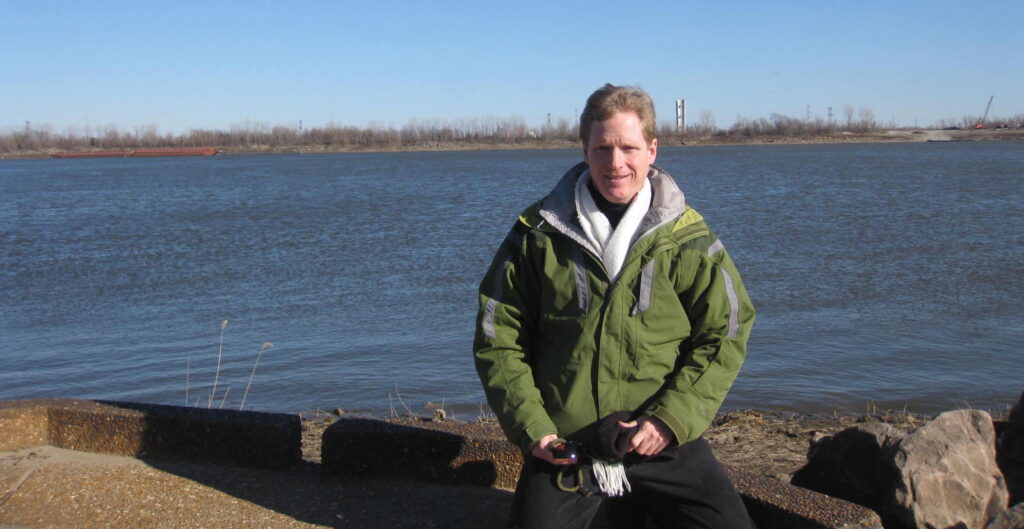
State #5 Arizona: Giving a climate change presentation at Grand Canyon National Park
As I wrote earlier on this blog post, in November 2012, I spoke at NASA’s Earth-to-Sky climate change seminar before the NAI (National Association of Interpreters) Conference in Hampton, Virginia. One month later, District Supervisor Ranger Pete Peterson at Grand Canyon National Park commented to me on Facebook:
“Brian, I need you to come to Grand Canyon National Park and jump start our interpretive climate change program. Let’s talk.”
With my fantastic memories of visiting Grand Canyon National Park over the years, I was not going to pass up this offer. Let me counter that, even if I had never visited Grand Canyon National Park, this was a huge opportunity not to be dismissed because it is the Grand Canyon.
Pete Peterson and I kept in touch over the next few weeks to brainstorm when I could come to speak at Grand Canyon National Park. In early 2013, we finally settled on a date of Tuesday, May 7th. At that time, I still worked as a seasonal park ranger at Crater Lake National Park. Thus, it was ideal to fit in a talk at the Grand Canyon during a cross country drive from St. Louis, where I spent the winters, to Crater Lake.
I did not know if I would get back to the southwest. In fact, I have not returned to the southwest since 2013. Since it was uncertain if I would return to this part of the U.S, I made the most of this cross-country trip driving from St. Louis to Crater Lake via the Grand Canyon.
On the first night of this journey, I stayed with my college friend, Brent Isaacs, at his home in Tulsa, Oklahoma. I then made a long drive to Santa Fe, New Mexico. I visited my Climate Reality and Citizens’ Climate Lobby (CCL) friend, Maria Rotunda and her family. I enjoyed walking around the old downtown area in Santa Fe before meeting my friend Maria and her family for dinner. Maria was the CCL Chapter Leader for the Santa Fe group. I joined CCL exactly one year earlier after attending a monthly chapter meeting in St. Louis. I wanted to see the monthly meeting for the Santa Fe chapter. They graciously to allowed me to sit in on their meeting.
From Santa Fe, I drove to Canyon De Chelly National Monument in Arizona to spend a day there. I took numerous pictures of the rock formations and the ancient ancestral Pueblo ruins as I hiked up and down the canyon on several short trails. Some of these ruins were high up on a cliff, which reminded me of visiting the ruins at Mesa Verde National Park over 10 years earlier. While working in the national parks for over 20 years at that point, some park employees told me Canyon De Chelly was their favorite NPS site to visit. I enjoyed the rugged desert beauty of that area. I felt grateful for the opportunity to visit this national monument.
The next day, May 6th, I arrived mid-morning at the eastern entrance, also known as Desert View, of Grand Canyon National Park. Within minutes of my arrival, I noticed a flyer advertising my evening program at the Shrine of the Ages Auditorium at Grand Canyon Village (or Canyon Village as the park employees call it) on the south Rim. Desert View is a 23-mile drive from Canyon Village. It was great to see advertisements for my talk greeting me as I entered the park.
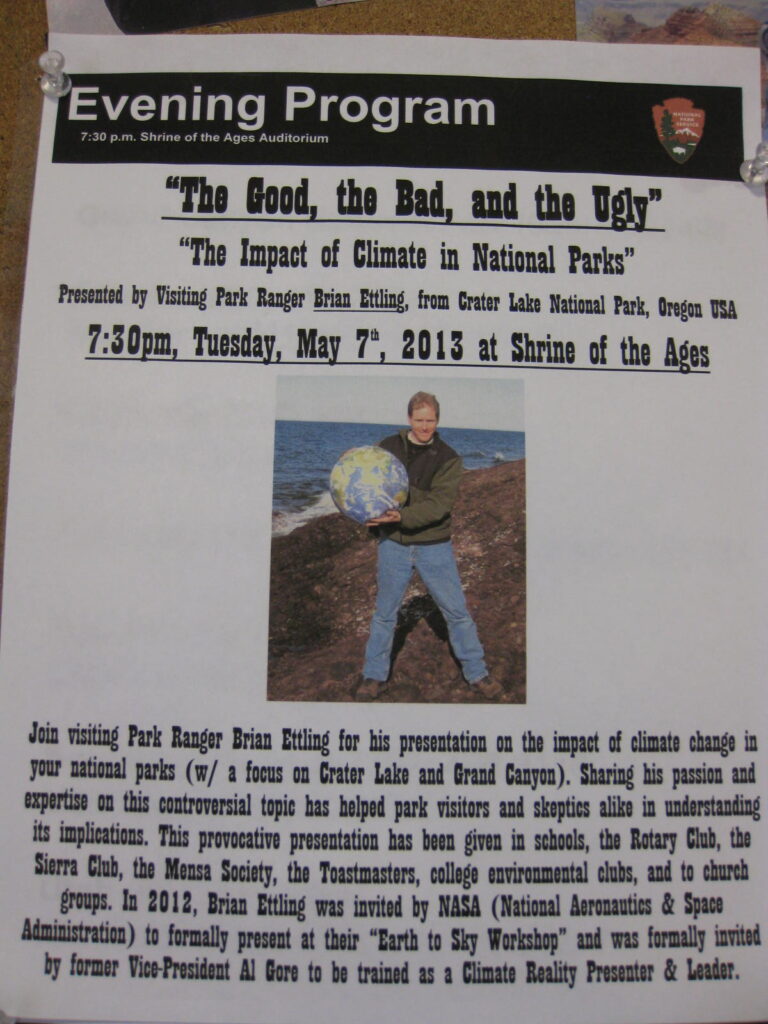
The 23-mile drive from Desert View to Canyon Village only takes about 36 minutes without stopping. It took me over three hours to drive it to stop at the numerous overlooks to get awe inspiring views and photos of the Grand Canyon. It was partly cloudy at Desert View. As the day progressed, it became more overcast, and the canyon looked a bit hazy that day. It was clear enough to see across the Grand Canyon and visibly see all the rock formations.
In 2009, I hiked on an overnight trip to the bottom of the Grand Canyon. In 2010, I completed a solo three-day backpacking trip from the north to the south rim on the Grand Canyon. Not only was it beyond words to admire the magnificence of the Grand Canyon, it brought back great memories when I hiked to the bottom in 2009 and 2010.
In late afternoon, I met up with my friend Pete Peterson. He briefly me about my schedule for the next day at the Canyon. I planned to give a version of my Crater Lake climate change evening program, “The Good, The Bad, and The Ugly” for my talk. I sheepishly asked him if he wanted me to include climate change information about the Grand Canyon in my presentation. He said yes. He wanted information about climate change at the Grand Canyon in my talk. Gulp. I got a knot in my stomach since I had no depth of knowledge about the Grand Canyon.
Pete then informed me that the next day he planned to give me a tour of the park’s facilities in Canyon Village that utilized solar and energy efficiency. Even more, he scheduled meetings with me and park researchers so I could quickly learn how climate change impacted the Grand Canyon. Then, in the evening of Tuesday, May 7th, Pete estimated I would probably be giving my evening ranger program to several hundred people at the Shrine of the Ages Auditorium.
My stomach was churning hard. It felt like I had about 24 hours to cram for a final exam on climate change at the Grand Canyon to give to an audience of several hundred park visitors and rangers attending. My head was spinning and my stomach had butterflies to pull together a presentation so quickly, but it was a lovely evening visiting with Pete and his partner Carrie. They cooked delicious home cooked meal. It tasted splendid after spending a week on the road.
While hanging with Pete and Carrie at their park house in Canyon Village, we saw an elk not far from their back porch. This amazed me because I had not really seen any elk in all my years working at Crater Lake National Park and just a few times visiting other national parks. This might have been the closest I had ever been to seeing and photographing an elk.
As dusk approached, Pete and his wife Carrie took me to see a wonderful sunset of the Grand Canyon from Yavapai Point in the Canyon Village area. The overlook was crowded with lots of visitors to get a glimpse of the sunset. The Canyon and the sunset were so captivating with the bright orange glowing colors that you could not blame anyone for being there, even if it felt like I had to out elbow others to get a photo.
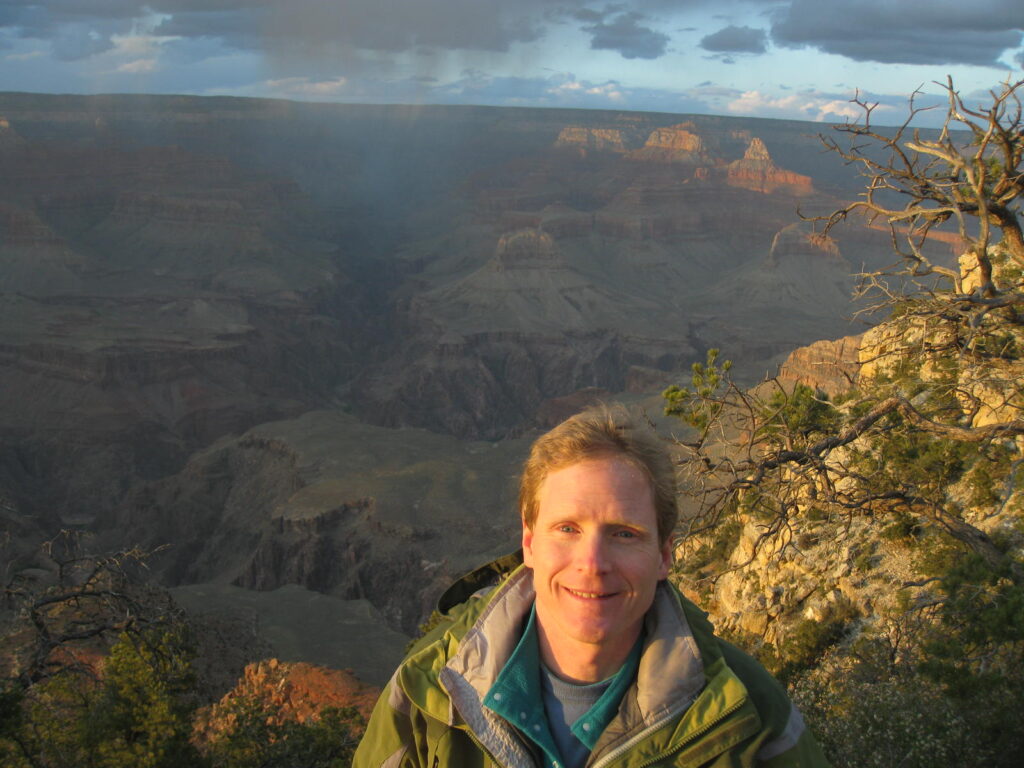
As I blogged about previously, Tuesday May 7th was an intensely hectic day to meet with park researchers and tour park climate friendly facilities to quickly learn information about the Grand Canyon to include in my evening program. By late afternoon, I had more than enough information about the problem and solutions of climate change at the Grand Canyon to squeeze into my talk. My stress level was off the charts when my 5-year-old Toshiba laptop froze up and crashed as I tried to piece together a PowerPoint talk with less than 3 hours. I was safely in the ranger park library. However, my laptop struggles felt like I was hanging dangerously over the edge of the Grand Canyon and about to fall several thousand feet.
To my relief, my laptop functioned well enough to complete my revised ranger presentation with information included about the Grand Canyon. I finished my PowerPoint with about two hours to spare before the start of my presentation. Fortunately, my ranger talk that evening went smoothly. Sadly, we did not get a video of my talk. It was a packed house of over 200 people, the largest in-person talk I have ever given. As far as I remember, they were a receptive audience. It was amazing to be able to reach that many people with a message about climate change. It seemed to be a whole section of park rangers in one part of the audience, which I hoped to chat with afterwards.
After my talk was completed, some people lined up to compliment me on my talk. To my dismay, I had a climate denier who wanted to argue about the scientific details in my talk. He wanted to hog my attention. I was very happy when Pete rescued me to break up the conversation so I could chat with other Grand Canyon rangers who wanted to meet me.
I did little sightseeing that day, but it still felt like a roller-coaster adventure. Pete had an ice cream dessert at his house afterwards to unwind and celebrate the day’s achievement.
It was a tough but rewarding opportunity speaking to over 200 people at the Grand Canyon about climate change. I recently thanked Pete Peterson again for one of the best experiences of my life. The next day, I enjoyed the view of the Grand Canyon from the Bright Angel Trailhead overlook before leaving the park to continue my road trip. The canyon was a bit hazy that day. At the same time, the Grand Canyon looked even more rewarding for me with my memories of hiking to the bottom twice and then speaking to my largest audience about climate change.
After leaving the Grand Canyon, I drove to Lake Havasu City, Arizona to visit my friends Steve and Melissa, who I used to work with in Everglades National Park. They took me to see the London Bridge and a boat ride across the lake to see Havasau City, California. The next day, I drove to California to spend five days visiting friends in Yosemite National Park. I had sunny weather and blue skies the entire time I visited. That gave me a perfect opportunity to hike the Mist Trail to see Vernal and Nevada Falls, hiking in the Glacier Point area, visiting the sequoia trees at Mariposa Groves, and hiking in the Yosemite Valley underneath Half Dome.
This was a massive gift from my friend Pete Peterson to give a climate change presentation at the Grand Canyon. It allowed me to go sightseeing and visit friends along the way from Tulsa OK, Santa Fe NM, Canyon De Chelly National Monument AZ, Lake Havasu AZ, and Yosemite National Park CA. I might have planned a much simpler and direct cross-country route from St. Louis, MO to Crater Lake, OR without that invitation to speak at Grand Canyon National Park. I possibly would not have visited as many friends as I did or spend the quality of time at Canyon De Chelly or Yosemite without that chance to give a climate talk at Grand Canyon.
Yes, that was extra driving and more carbon emitted by my manual transmission fuel efficient Honda Civic. At the same time, it is spending time in nature in the fantastic scenery like Yosemite, the Grand Canyon, Canyon De Chelly and other natural areas that inspires me to give talks and organize for climate action. My remaining cross country seasonal trips from St. Louis to Crater Lake in the spring and vice versa in the fall were much more direct because I did not have another opportunity like that to give a big presentation during a cross country drive.
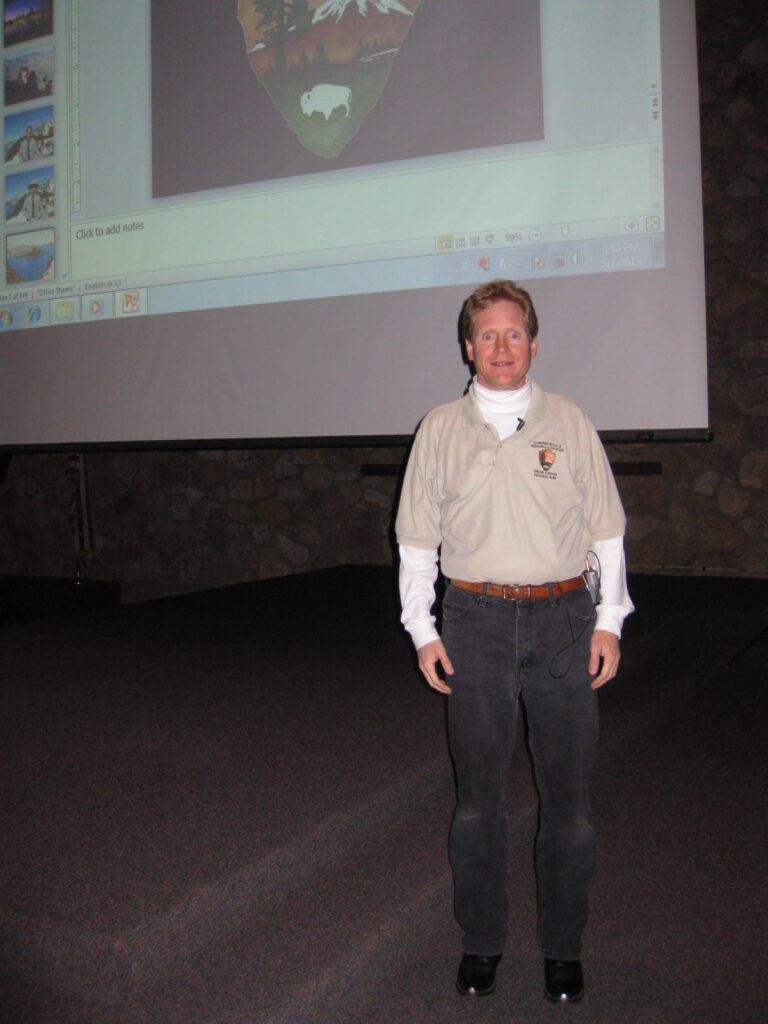
State #6 California: Appearing as a TV guest on Comedy Central’s Tosh.o
After I developed the www.climatechangecomedian.com website in 2010 and giving some climate change talks in St. Louis, Crater Lake, and elsewhere, I struggled with what to do with the Climate Change Comedian title. My climate change talks as a park ranger, Toastmaster, Climate Reality Leader, and Citizens’ Climate Lobby volunteer were not leading to any notoriety.
To up my exposure, I created some YouTube videos. On January 10, 2014, I created my first minute and a half video, “Climate Change Comedian and the Violinist!” with Tanya Couture, my girlfriend then and wife now since 2015. I tried to promote her as a professional violinist and highlight me as a climate change public speaker.
One month later, on February 6, 2014, I shot the second video with my mom, Fran Ettling, “Climate Change Comedian and the Pianist!” This two-minute video showcased my mom as a professional pianist and promote me as a climate change public speaker. In both videos, I developed my tag line with Tanya in the first video and my mom in the second remarking: “You’re not that funny!”
One year later, my dad was tired of his role as the cameraman. He asked if he could be in a video. The next video, I filmed on March 6, 2015, “Climate Change Comedian and his Skeptical Dad!” It was the longest video I created with family at 4 and a half minutes. In this video, my dad and I chat about his story how he went from doubtful on the science of climate change from listening Rush Limbaugh to accepting the science. He stated that he shifted his thinking from my information about seeing climate change in the national parks. Like the previous videos, I attempted to be funny. This time, my dad gave the tag line: “No, you are not that funny!”
It was a funny family project to do these videos with Tanya and my parents. I forgot about them and moved onto other projects.
Then in April 2016, something unexpected and magical happened. I spent the winter of 2015-16 getting married to Tanya in a big celebration wedding attended by family and friends on November 1, 2015. I gave lots of climate change talks that winter and I was planning on returning to Crater Lake for the summer. In mid-April, I was getting ready to start packing up my belongings for the summer when the phone rang at my parents’ house. My mom informed me that “someone from Los Angeles wants to chat with you.”
I picked up the phone and the person identified himself as a staff member of Comedy Central’s Tosh.o. We had a very friendly conversation where he asked me about my background such as “The Climate Change Comedian,” and making the YouTube videos with my parents and Tanya. He then got to the point asking me: “We would like to fly you and your mom out to Los Angeles to appear on a taping Comedy Central’s Tosh.o next week to be interviewed by our host Daniel Tosh. Would you be interested?”
“Yes!” as I serendipitously jumped at this opportunity.
We then wrapped up the phone call. I then approached my mom about this invitation and shared that they wanted to include her. I asked if she would be interested in getting flown to LA to appear on a national TV show.
Her response was a coy and very intrigued response of “Yes.”
The show felt bad they invited my mom and I to LA when Tanya planned a brief honeymoon trip to Augusta, Missouri that week. As a wedding gift the previous November, we received a gift certificate for a two-night stay at a bed and breakfast there. To rectify this, the show invited Tanya to join us. They paid for our airfare and hotel in Los Angeles for the three of us to briefly visit and video tape this interview. Don’t worry! Tanya and I then took the trip to Augusta, MO after this overnight trip to Los Angeles.
This TV interview on Tosh.o was not like one of my traditional climate change talks. Daniel Tosh dominated the interview with his jokes and roasting of me as the Climate Change Comedian. While I played the straight man to his skillful use of humor, I inserted information how climate change is real, caused by humans, and we can reduce the threat if we act now.
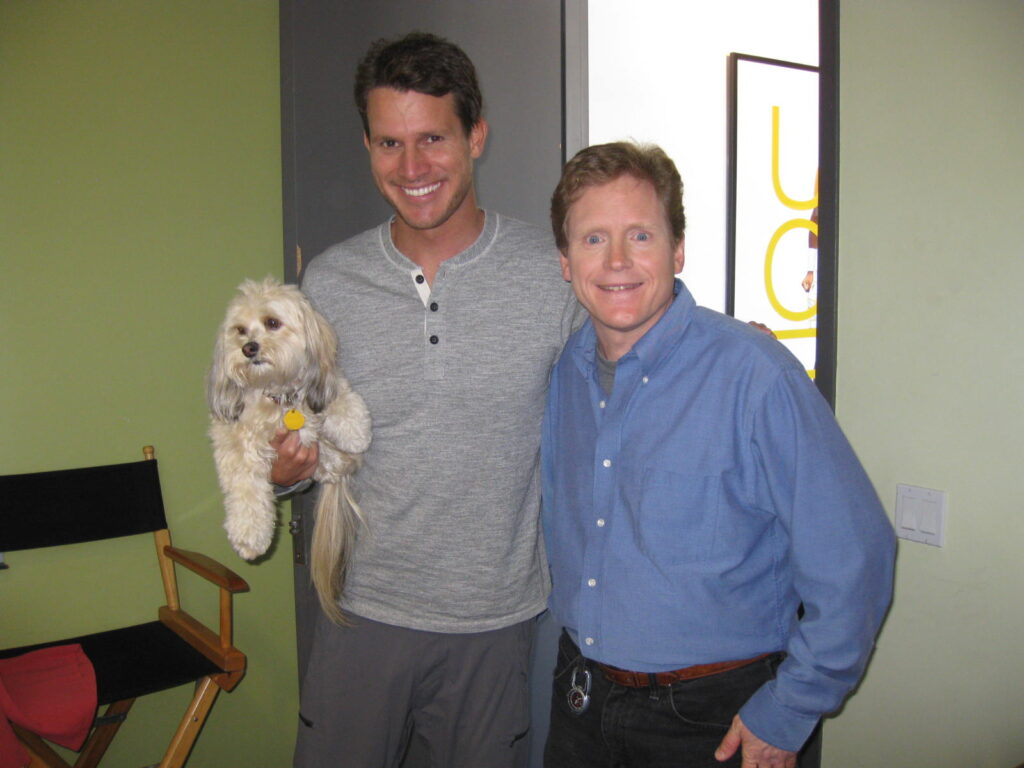
My mom, Tanya, and I nervously waited for the show to be aired on August 2, 2016. To our delight and relief, the segment was hilarious. We were very satisfied how we appeared on national TV. To this day, appearing on Comedy Central’s Tosh.o was one of the highlights of my life. In one sense, I never dreamed when I gave myself the title “Climate Change Comedian” back in Ashland, OR in 2009 that it would lead to a TV appearance seen by millions of people. This reached an audience, especially of young high school and college age Gen Y and Z viewers, primarily male, that regularly watch Tosh.o. These are folks that might not ever attend a park ranger program on climate change or see a scientific lecture on the climate crisis.
Even more, this show episode immediately went into syndication where it was shown several times over the next few months and years on Comedy Central. I had friends tag me on Facebook when they saw my episode months or even years later. My appearance on the show paid extremely well. My mom said she was able to pay to get dental work done from the check she received from the show. Years later, I continued to receive residual Screen Actors Guild checks from my appearance on Tosh.o.
Giving a climate change talk at 2016 Citizens Climate Lobby Conference in Ottawa Canada
Like so many people, I felt sick to my stomach when Donald Trump won the Presidential election on November 8, 2016. I felt naueous like years of all my climate organizing, writing and public speaking went down the drain. For a couple of days, I had no energy to do anything.
Then I exchanged Facebook messages with my Climate Reality and Citizens’ Climate Lobby friend, Cathy Orlando. In September 2010, Cathy founded and became National Director of Citizens’ Climate Lobby Canada (CCL Canada). For years, I admired her leadership in CCL Canada. I had friends who enjoyed attending the CCL Canada lobby days in Ottawa, Canada to engage with Canadian members of Parliament. I wanted to directly participate, so I signed up in September to attend their November 2016 conference.
In November 2016, Cathy reached out to console me the day after Donald Trump won the 2016 Presidential election. Somehow, we talked about a Toastmasters speech I gave in April 2016, “Hey U.S.A! Let’s win the Clean Energy Race!” The theme of the speech was that the U.S. could either be a leader or a laggard to compete with China on clean energy. Cathy read my blog about the speech and watched the YouTube video. She then asked me to present this speech at the CCL Canada conference in Ottawa on November 27, 2016.
For this presentation, Cathy asked me to expand it to include Canada. Thus, I renamed the speech, “Hey North America! Let’s win the Clean Energy Race!”
I arrived in Ottawa on the day after Thanksgiving, on Friday, November 25, 2016. Not surprising, it was a bone chilling overcast day in Ottawa. The gruff Canadian customs officials asked me what I was doing in Canada. I told them I was there to give a climate change talk at a conference happening that weekend. They did not believe me. They had me turn on my laptop and show them some of my PowerPoint slides. When they saw a small part of my presentation, they decided I was legitimate. They then thanked me for my efforts as a climate organizer.
Tanya decided two weeks earlier to join me on this trip. Unfortunately, she could not book the same flight as me, so she arrived at the Ottawa airport a couple of hours after me. She missed all the drama I had with the Canadian customs officials. When she arrived in Canada, she simply told them that she was there to visit friends. They immediately waved her through.
After Tanya arrived, my Climate Reality and CCL Canada friend Rolly Montpellier picked us up at the airport and generously let us stay at his home during the conference. As an active volunteer with CCL Canada, Rolly planned to attend the conference and lobby day. He kindly let us ride with him to the conference each day.
A CCL conference and lobby day in Washington D.C typically has over 1,000 people. The population of Canada is only about a tenth of the U.S. population (40 million vs. 330 million). It made sense that around 100 people, nearly all Canadians and a couple of Americans, such as Tanya and me, attended this conference.
My talk, “Hey North America! Let’s win the Clean Energy Race!” went well for this conference and the attendees seemed to like it. The conference video recorded all the speeches, so I uploaded my speech to YouTube afterwards. Tanya captured some good photos of me speaking.
The next day and a half, Tanya and I joined over 55 CCL Canada volunteers to lobby members of Parliament at their offices. The Parliament buildings and downtown Ottawa is charming. As an American, it looks very British. If Great Britain and the U.S.A. had a child, it would look like Canada. My parents took my sisters and I to drive through Ontario, Canada as part of a family vacation to see Niagara Falls in 1983. We saw Ottawa in July and I always wanted to see it again. In between the lobby meetings, Tanya and I explored the majestic, Gothic style, Parliament Building and the surrounding grounds.
All our lobby meetings were face-to-face with members of Parliament. Tanya and I were split up to attend separate lobby meetings. In October 2016, Prime Minister Justin Trudeau and his Liberal Party announced a plan to establish a carbon fee and dividend in 2018. The priority of our lobby meetings was to thank the Liberal Party members and to urge full implementation of the carbon fee and dividend.
Tanya and I were often the only Americans in these lobby meetings. The election of Donald Trump happened just a couple of weeks previously. The members of Parliament often turned to Tanya and I in our lobby meetings to ask: ‘What just happened in your election?’
I was still stunned by the 2016 U.S. Presidential election result. This was the first time Tanya participated in climate lobbying anywhere. She felt amused and uncomfortable that she was put on the spot in these meetings to answer why the U.S. elected Donald Trump as President.
This was another peak experience for me as a climate speaker and organizer to give a talk in Ottawa and lobby members of Parliament in Canada. After this talk, I could now brag that I was an international climate change speaker.
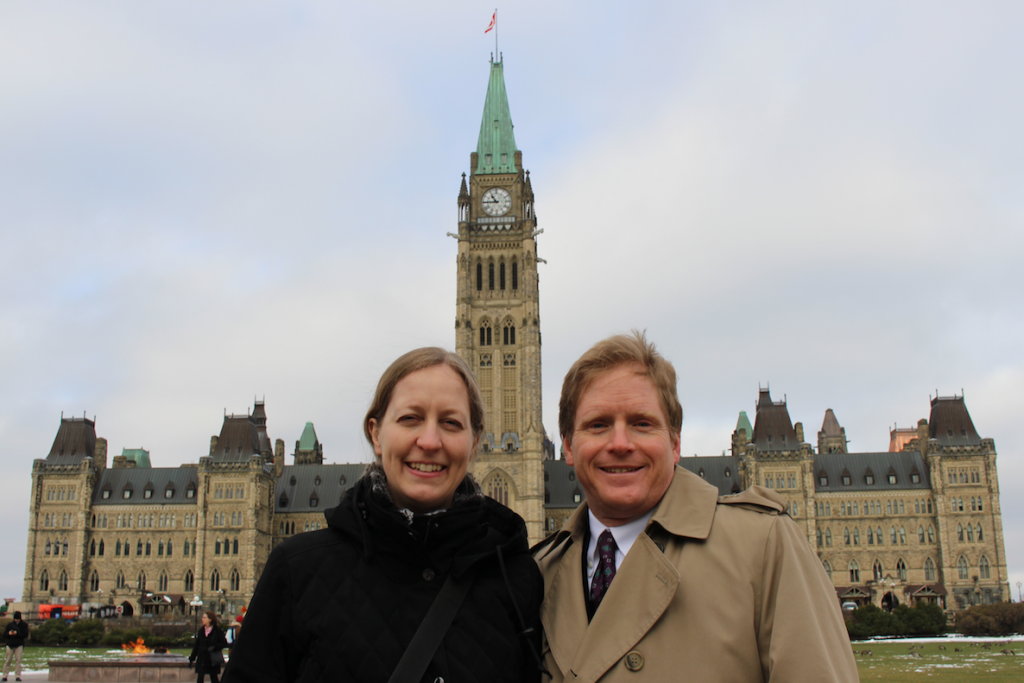
#7 Colorado: Breakout speaker at 2017 Climate Reality Day of Action Training in Denver.
After I was trained as a Climate Reality Leader in San Francisco, California, in August 2012, I was an active Climate Reality Leader and mentor. I attended Climate Reality Trainings as a mentor in Chicago IL in 2013, Cedar Rapids IA in 2015, and Houston TX in 2016. Climate Reality Project asked their volunteer Leaders like me to log their “Acts of Leadership” on their Hub website so they could track our actions. Even more, logging our climate actions enabled other Climate Reality Leaders to see how we took specific climate actions to inspire them to do the same.
Therefore, I logged all my climate change talks, as well as the opinion editorials I wrote that were published in the St. Louis Post-Dispatch and newspapers across Oregon. I recorded each of my blogs from my climatechangecomedian.com and my writing contributions for the climatebites.org website. I submitted each time I taught a continuing adult education class for St. Louis Community College and the Oasis Continuing Education Center in St. Louis. I logged each time I lobbied a member of Congress, wrote a letter to them, emailed them, and called their office. I recorded each time I attended climate related meetings and organized climate events. Because of all the times I submitted climate actions, I became known from 2014-2020 as one of the top Climate Reality Leaders for my recorded Acts of Leadership.
Because of all of my logged “Acts of Leadership,” the Climate Reality staff invited me to be a guest speaker at their March 5th Denver Day of Action. This event took place after the March 2017 Climate Reality Training in Denver, Colorado March 2-4. The staff asked me to speak about “Spreading the Word: Mastering Presentations.”
In that talk, I shared my 6 tips for Mastering Presentations such as:
- Sharing your story.
I told my story I how saw climate change working as a park ranger in the national parks. - What common values do you share with your audience.
I shared how I related to my audiences with their love of the national parks and nature. I quoted Holocaust victim Anne Frank from her book, The Diary of a Young Girl:
“The best remedy for for those who are afraid, lonely or unhappy is to go outside, somewhere where they can be quite alone with the heavens, nature, and God. Because only then does one feel that all is as it should be…amidst the simple beauty of nature.” - Include the mission statement for the group that invited you.
When I spoke at Second Presbyterian Church in St. Louis, Missouri in January 2017, I included their website statement that they are “a certified Earth Care Congregation in the Presbyterian Church (USA) since 2012. ”
From Rotary Clubs, I included their Four Way Test:
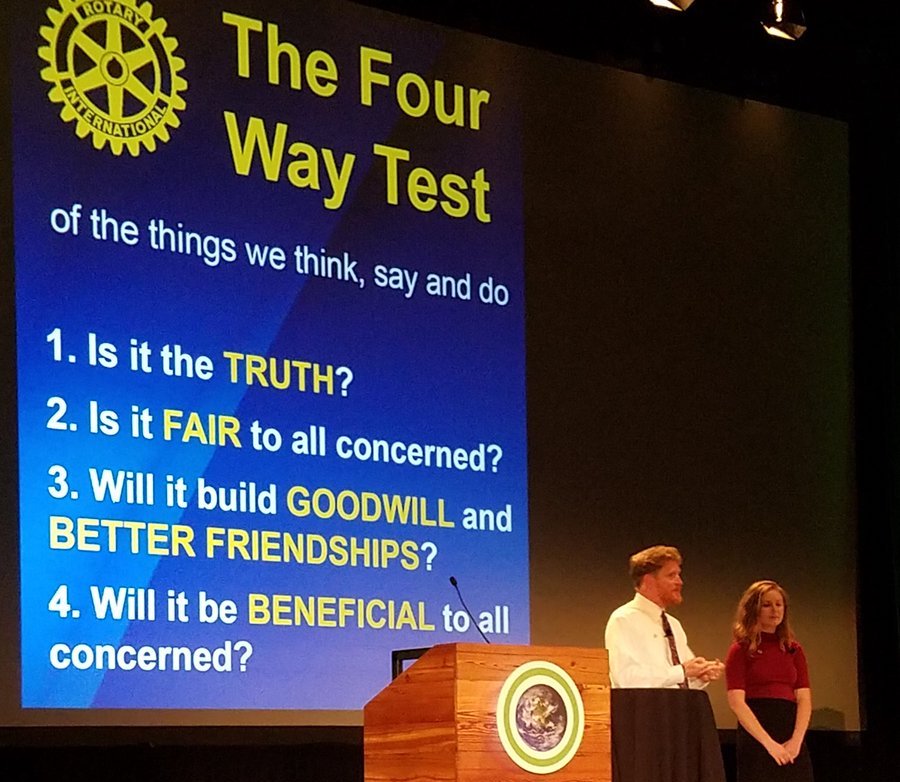
- Include your audience in your talk.
I then talked about how I would show up at meetings of an organization weeks before my talk to get permission to take photos of individual club members to weave them into my talk. The audience loved seeing their friends and themselves in my PowerPoint images. - If possible, Include some humor.
I would share the viral image Positive proof of global warming that shows the changes in underwear fashion over the years. I also included the Bloomberg Business article that I had the unfortunate experience to wake up to the day after my wedding on November 2, 2015, “Climate Change Kills the Mood: Economists Warn of Less Sex on a Warmer Planet.” - Share local stories of the problem and solutions to climate change.
I showed the image of the extreme flood that I saw in St. Louis on January 1, 2016. I then shared the story in the Webster-Kirkwood Times, “Living Green With Solar Energy,” from December 14, 2012. The article highlighted St. Louis residents Jim and Judy Stroup. They installed solar panels on their house the year before and saved around 87% on their electric bill. I included the quote from Jim Stroup:
“This past month, I spent more beer & pistachios than I did on gas & electric. And I am not a big drinker. It’s amazing how much (solar) cuts down on your bills and how economical it is to install.”
I then wrapped up my presenting by listing my 6 tips for mastering the presentation for the audience to see it one last time.
This presentation was well received by the audience of primary Climate Reality Leaders and staff. I remember seeing fellow Climate Reality Mentors there such as Harriet Shugarman, Jill MacIntyre Witt and Maria Rotunda. They gave me positive feedback about my talk. Maria’s son, Ian Marchegiani, took a great picture of me speaking.
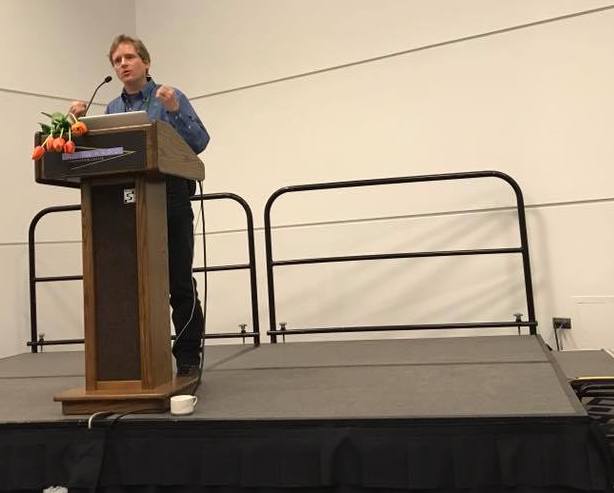
Giving climate change talks in Washington D.C. at Citizens’ Climate Lobby conferences
In February 2017, my wife Tanya and I moved to Portland, Oregon. My wife’s job transferred us to Portland, but I was unsure what to do with my life. I knew I wanted to be a climate organizer. I was uncertain what I was precisely going to do and how I would make a living doing that. For the previous 24 years, I worked as a seasonal park ranger at Crater Lake National Park during the summers. For 16 years, from 1992 to 2008, I worked as a winter seasonal ranger in Everglades National Park. People knew me as a park ranger. That job opened doors for me to give climate change presentations. I loved that job.
By 2017, I wanted to transition out of being a seasonal park ranger to be a full-time climate organizer. In May, I blogged “My struggle to transition from a park ranger to a climate lobbyist.” I had a hard time weening myself away from the ranger job. I worked at Crater Lake in May 2017 as the park needed ranger staff during that month to start ramping up for the summer visitation. At that time, I did not commit to work at Crater Lake beyond the first week of June.
For the summer of 2017, it was time to do something different. I did not want to attend the Crater Lake interpretative ranger seasonal training. I was eager to attend the June Citizens’ Climate Lobby (CCL) Conference and Lobby Day, June 10th to June 13th. This was a couple of days after my final day of work at Crater Lake. Even more, I wanted to do more than just participate in this June CCL conference. I asked CCL if I could be a breakout speaker for this conference.
In January 2017, I gave a Citizens’ Climate Lobby online training about climate change in our national parks. I described this training as:
“Unsure how to find common ground when you meet with a member of Congress or Congressional staff? Most likely, a National Park Service (NPS) unit exists in the district of your member of Congress or inside your state. It is vital to know how climate change negatively impacts these national treasures and how the NPS works to reduce their carbon footprint in each of their units. National parks and monuments may be an economic linchpin for many Congressional districts.
Join seasonal park ranger and Citizens’ Climate Lobby volunteer Brian Ettling as he discusses how he has witnessed climate change while working in the national parks. He will share how he has used his experience and love of our national parks to achieve common ground in meetings with Congressional staff. Even more, he will share examples of two national parks working to reduce their carbon footprints.”
My lobbying experience showed me that one of the best ways to find common ground with Congressional staff was to talk about nature and national parks. In addition, climate lobbying can seem discouraging looking at the news with worsening weather events and Congressional inaction. CCL often likes to use the quote from E.B. White,
“I arise in the morning torn between a desire to improve (or save) the world and a desire to enjoy (or savor) the world. This makes it hard to plan the day. But if we forget to savor the world, what possible reason do we have for saving it? In a way, the savoring must come first.”
For the June 2017, I wanted to lead a breakout session on the importance of protecting nature and our national parks as we lobby for Congressional offices to pass climate policy. The CCL staff went along with my idea.
We agreed on a panel breakout session called, “Protecting and Conserving Species in the Face of Climate Change.” CCL suggested two panelists, Dr. Brooke Bateman, Director of Climate Watch for the National Audubon Society, and Leah Donahey, Senior Campaign Director for the Alaska Wilderness League. My responsibility was bring in a third speaker from NPS.
My NPS friend from Earth-to-Sky, John Morris, suggested that I contact Jon Jarvis, the recent Director of the National Park Service from 2009 to 2016. I then emailed Jon Jarvis. He replied that he must graciously turn down the invitation. He was interested in the June 2017 conference panel, but he had to decline to observe by law “a one year ‘cooling off’ period where I cannot be engaged in any ‘matters of substance’ related to the NPS.”
I then offered the spot to John Morris. He accepted the invitation, but then he had to back out due health issues. Other NPS rangers I approached where not available. Thus, I was the third speaker and the moderator. My talk was about the pika, a small mammal that is closely related to the rabbit. Because it lives in cool mountain high elevations in the western U.S, it is an indicator species for detecting climate change. I shared how Crater Lake and the national parks are attempting to switch to clean energy for its facilities to reduce the threat of climate change.
I remember having around 30 people in the audience for this breakout session. I was pleased that it went smoothly, since I wore two hats as the moderator and a panelist speaker for this presentation. I did not notice I was filmed when I moderated the breakout session. Ashley Hunt-Martorano, a friend and the CCL Marketing and Events Manager at that time, came into this session and shot a quick video on her phone during the question-and-answer portion with the audience. I appreciated her recording this short video to document the occasion.
For the June 2019 CCL conference in Washington D.C, CCL approved for me to co-lead another breakout session on “Mastering Town Halls” with fellow Climate Reality Leader and CCL volunteer Eve Simmons. For the last couple years, I had attended several Congressional town halls in Oregon. I had some success of engaging with Oregon’s U.S. senators and a member of Congress. Sadly, I was the only CCL volunteer present at some of these town halls. Therefore, I wanted to lead a breakout session about tips I discovered to engage members of Congress, their staff and the community at local town halls.
Eve and I did not get a big audience for this breakout session. I remember us having less than 20 people in a room that could have probably held around 40 people. Except for a couple of people who had questions for us and gave us feedback that it was helpful, we did not seem to get much of a response from the audience.
Eve and I struggled at times to get our ideas and messaging in our talk in sync. However, I was very proud to give this talk on the importance of “Mastering Town Halls.” In my experience in Oregon, I had not seen much climate advocates, especially CCL volunteers, at town halls. I hoped to raise awareness about that in some way that I could.
#8 Washington state: Giving a breakout talk at the Climate Reality Bellevue Training
Just two weeks after the June 2017 CCL conference in Washington D.C, Climate Reality Project invited me to be a breakout speaker for their Training in Bellevue, Washington on June 27-29, 2017. After my March Climate Reality Day of Action breakout presentation in Denver, Colorado, Climate Reality staff kept in contact with me. They were pleased with my volunteer actions.
As a result, they invited me to be a co-breakout speaker with Maddie Adkins at the Climate Reality Training in Bellevue. This was very exciting because I was Maddie’s mentor at the Climate Reality Training in Houston, Texas in August 2016. She was 17 years old when I met her in 2016. I helped her with her mentor application for the February 2017 Denver training. I was happy for her when Climate Reality invited her to be a mentor. Even more, it was very exciting when she was selected as one of the panelists, along with Lucia Whalen, David Ellenberger, and Nana Firman CLIMATE REALITY LEADERS: WHO WE ARE panel discussions led by Al Gore at the Denver Training. From meeting her at the Houston Training, we developed a good rapport.
Maddie Adkins is the name she is known by her family, friends and Climate Reality. She writes and promotes herself professionally under her given name of Madison Adkins. As a teenager, she created a lot of buzz when she lived in Carmel, Indiana. She worked with her mayor and city council on a climate change resolution. She gave speeches at schools and universities to educate young people about climate change and their power as citizens. In 2017, she worked at iMatter, an international youth-led organization that empowers youth to join the climate movement. Before I left for the training in Houston, I received messages from friends telling me how excited they were that I was her mentor and the great things she was doing for climate action.
It happened to be very beneficial that my wife Tanya and I moved to Portland, Oregon in February 2017. Maddie lived in Portland with her parents at that time. Thus, we met in person to prepare and practice our presentation in early June. We were scheduled to give this talk in Bellevue at the Climate Reality Training at the end of June. I really did appreciate her bubbly, joyous youthful enthusiasm, and excitement to give this joint presentation with me. Her playful and exuberant personality helps bring out the fun and creativity in those around her, especially me. I fed off her impish teen energy and she enjoyed my goofy and wacky personality. We practiced hard to do a great job giving this presentation at the training.
We enjoyed weaving together our presentations together in a cohesive talk. Maddie focused on how to speak to youth and schools. I focused on how to speak to adults. I shared the six tips for mastering the presentation and finding an audience that was from the Climate Reality Day of Action talk I gave in Denver just a few months before this June talk. I added a new original quote I created that I have used in the conclusions of my climate change talks since then:
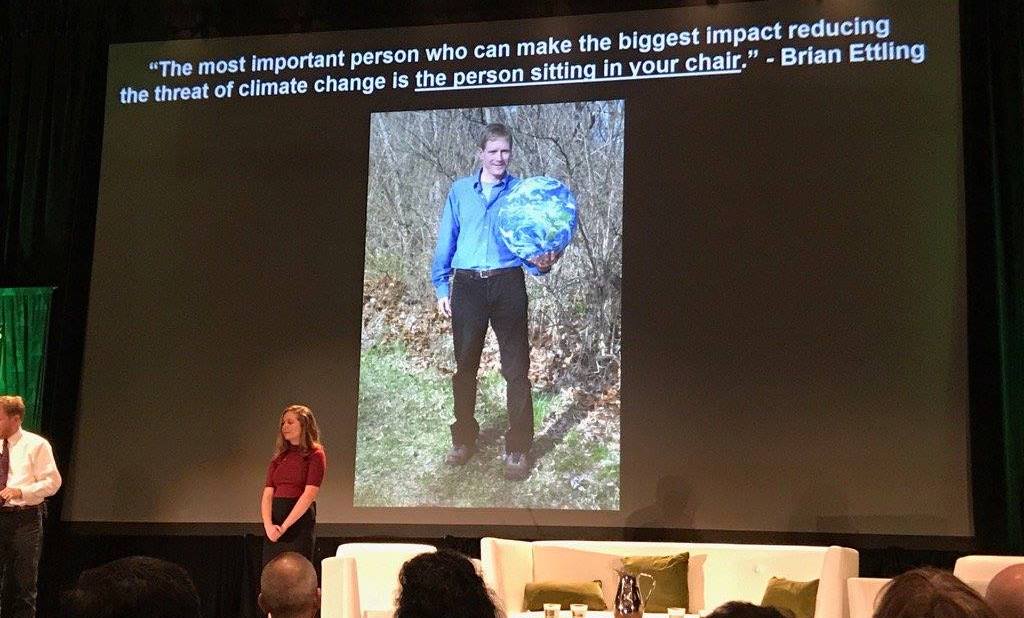
Maddie had great tips for our talk that she later wrote about for an August 7, 2020 article for Medium.com, “How I Grew My Public Speaking Audiences from 10 to 1,000.” In her 2020 article, her helpful tips included: practice, invite your friends to your presentation, expect tech issues, tell your story, follow up, and your authenticity is what makes your presentation powerful.
As we practiced our talk in Bellevue the day the day before we gave it, I mentioned to Maddie one of my all-time favorite quotes associated with the poet and author Maya Angelou:*
“People will forget what you said…but people will never forget how you made them feel.”
Maddie loved hearing that quote. She decided on the spot that would be the conclusion of our talk. She ended her 2020 Medium article with that same quote. With the busyness of our lives, Maddie and I lost contact after that talk. It seemed we were two energetic atoms bouncing off each other. We each received an inspirational boost in our climate advocacy since that collaboration and giving this talk in Bellevue together in 2017. I will always be grateful for Climate Reality Project pairing me up with Maddie to give this talk.
The large audience of Climate Reality Leaders who attended our breakout talk gave us a very positive response. Even more, the Climate Reality staff was delighted with our talk. It felt like the organization appreciated all my climate advocacy.
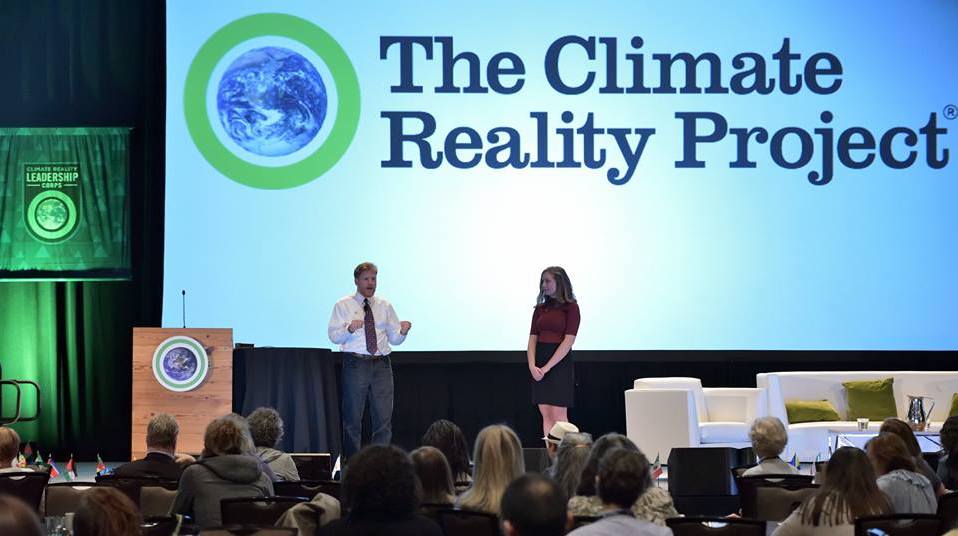
#9 Florida: Giving a climate change talk at the CCL regional conference in Tampa
In January 2014, I attended the CCL southeast regional conference in Atlanta, Georgia. Former Congressman Bob Inglis was the main conference speaker. I wanted to see him speak live and possibly meet him, so I registered to attend this conference.
At this conference, I met Abhaya Thiele, the CCL Southeast Regional Co-Coordinator and the Florida Co-Coordinator. Abhaya and I struck up a friendship with our love of Florida. She lived part of the year in the northern part of the state in Gainesville. I lived for sixteen years in Everglades National Park at the southern end of the state. Because I first learned about climate change when I started giving ranger talks in the Everglades in 1998, my dream was to return to Florida to give a climate change talk. Since our 2014 meeting in Atlanta, Abhaya and I kept brainstorming how I could return to Florida to give a climate change talk and promote CCL.
In December 2017, Abhaya invited me to be a guest speaker at the Florida Regional Conference for CCL that was held on February 24, 2018 in Tampa, Florida. This was a dream come true for me to return to Florida to give a climate change talk. I first learned about climate change when I started giving ranger talks in the Everglades in 1998. Ten years later in 2008, I stopped working in Everglades National Park because I was so worried about climate change.
Over my 16 years of working in the Florida Everglades, I made many friends. One friend, Steve Robinson, a fourth generation Floridian who worked in Everglades National Park from 1980 to 2005, became a mentor to me. Sadly, Steve passed away from pancreatic cancer in 2007. During that heartbreaking time when Steve fought cancer, I met Steve’s family, such as his brother Michael and his cousin Paul “Steb” Sedwick. Both Steb and Michael lived in the Tampa area. The day before the Tampa conference, I spent the day visiting with them.
On February 24, 2018, I gave my talk at the CCL Florida Regional Conference. My topic was “Storytelling: Reaching People Through Common Values.” My first point was that everyone has a climate change story, even if they don’t think they have one. I shared my story how I became aware of climate change while working in the Everglades as far back as 1998.
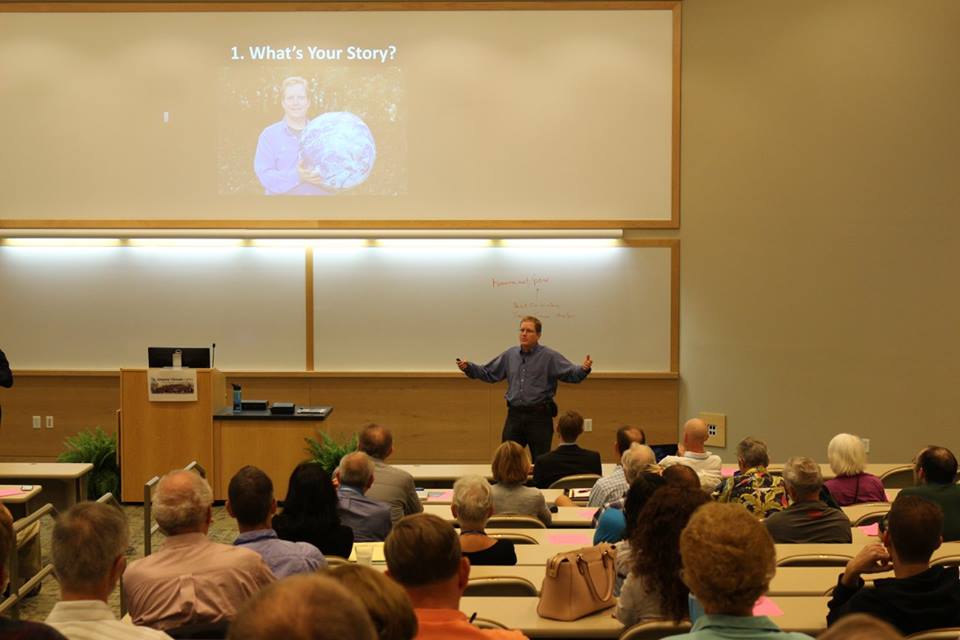
My second point was telling a local story about climate change that relates to your audience. As an example, I gave my story that I share in Oregon how I saw climate change while working at Crater Lake National Park, Oregon with the summer wildfire season becoming more intense.
My third point was sharing a personal story for why pollution is bad. I told my story how my dad has stage 4 bladder cancer. For years, my family lived just a couple of miles from the Meramec Coal Power Plant. I cannot say with certainty that the pollution from that plant caused my dad’s cancer. However, the air pollution from that plant certainly increased the risk of cancer for my dad and many others in the nearby St. Louis southern metropolitan area.
My fourth point was encouraging the audience about to talk about conservative Republicans who support climate solutions, such as carbon fee and dividend. I gave examples of former U.S. Secretary of State George Shultz, former Secretary of State James A. Baker III, and former Congressman Bob Inglis.
My fifth point was telling stories how CCL helped them have breakthroughs in their political power. My example was my success getting opinion editorials published in the St. Louis Post-Dispatch, the Oregonian, and other newspapers.
My final point was urging them to share the story of Pennsylvania businessman Jay Butera. He made numerous trips to Florida and Washington D.C. to convince Republican members of Congress such as Carlos Curbelo, Ileana Ros-Lehtinem, and others to join the bipartisan House Climate Solutions Caucus.
Around 75 people attended this conference. They gave me a grateful response for my talk. After the conference, my friend Climate Reality and CCL friend Susan Nugent and her partner Roland Fisch drove me from the conference in Tampa to their home in Gainesville, Florida.
The next day, Susan drove me from her home to the nearby Paynes Prairie Preserve State Park. That park reminded me of Everglades National Park, with the wide variety of wildlife we saw that day, such as alligators, Glossy Ibis, ducks, a Limpkin, a brown snake, Moorhens, a ribbon snake, horses, Cattle Egrets, Woodstorks, Great Egrets, a Snail Kite, a soft shelled turtle, and even bison. Yes, you read that correctly: bison. My wife was floored when she saw my photos of bison. She did not think that bison lived in Florida. They are not found in south Florida where the Everglades is mostly marshy and swampy. However, a small heard of bison thrives in the large area of this state park and the higher dry ground of northern Florida.
The next day, Susan and her partner Roland drove me to Cedar Key, on the Florida Gulf Coast. Cedar Key is about an hour and a half drive from Gainesville. I enjoyed seeing this coastal nature preserve that was nestled on the Gulf of Mexico. Cedar Key had some archaeological shell mounds, rising up to 28 feet above sea level. Scientists date them as nearly 6,000 years old, built over a 3,500-year period (2500 B.C.-A.D. 1000) by the first native Floridians.
Like my previous climate change speaking trips, it was a fabulous perk to meet up with friends and go sightseeing in the days after giving a climate presentation. Even more, I got to visit Florida in the middle of winter when the temperature was around 80 degrees Fahrenheit, but much colder in most of the United States, including our home area in Portland, Oregon.

#10 Idaho: Speaking at 2018 CCL Greater Northwest Regional Conference in Boise
Just two weeks after I traveled to Florida, I went to Boise, Idaho to attend the CCL Greater Pacific Northwest Regional Conference, March 9-11. The organizer of this conference was Roberta D’Amico. My supervisor at Crater Lake National Park, Marsha McCabe, was good friends with Roberta. They knew each other as career National Park Service employees. Marsha encouraged me to get to know Roberta since Marsha knew we were both involved with CCL.
I had a good conversation with Roberta and her partner John at the November 2017 CCL conference in Washington D.C. She was the lead organizer for the March regional conference and unsure who to recruit as speakers for the conference. I offered to help any way I could, including as a guest speaker if she needed me. In November 2017, we promised to stay in contact to exchange ideas. In January 2018, Roberta decided that she wanted me as a guest speaker at the conference. Even more, she determined that I would speak twice during the conference.
First, I gave a recap of the CCL Oregon Stewardship Tour that I led the previous October and November. This was a 30-minute presentation that talked about the lessons I learned for the tour. The main lessons I learned:
- Develop a planning team for a tour.
- Recruit a marketing team.
- Share your climate change story
- Emphasize local impacts your audience witnessed, such as the wildfires in Oregon.
- Every audience is different: From high schoolers to seniors, liberals to Trump supporters
- It was an adventure of a lifetime for me to lead that tour.
In addition to the lessons learned, I debriefed on items we could have done better for the tour:
• Don’t list Congressional lobby meetings on the official tour site. Very confusing for the media.
• If possible, try to have more than one presenter on the tour.
• Try to sponsor a tour with another group, like the Audubon Society.
• Put constituent comment forms and postcards on each seat before the event.
• We built goodwill with Renew Oregon promoting their state level cap and invest proposal. However, it made the talk more awkward and confusing since Renew Oregon and CCL’s solutions are completely different.
• Faster follow up with new supporters to become active volunteers – line up mentors in advance.
Second, Roberta thought it would be good for me to give an entertaining talk during dinner. My 10-minute talk centered on “What’s Your Story?’ A friend of mine recorded a video of this speech that I later uploaded to YouTube. Furthermore, I took the text of that speech and turned it into a blog, “For effective climate action, tell your story.”
Since the Northwest is much more geographically spread out than Florida, I remember this Greater Northwest Conference as having a smaller attendance of around 50 to 75 people than the conference I attended in Florida the previous month. The attendees at this conference liked my talks. Unlike other speaking engagements, I was not able to do any sightseeing in Boise. The good news though was that this was the first climate conference I attended where I was asked to present twice on two different subjects. That alone felt like a victory.
#11 Georgia: Co-presenting at the 2019 Climate Reality Training in Atlanta
After presenting as a guest breakout speaker at the Climate Reality Denver Day of Action in March 2017 and as a co-presenter for a breakout session at the Climate Reality Training in Bellevue, Washington, Climate Reality Project staff invited me to be a co-presenter along with Itzel Morales Lagunes at the Climate Reality Training in Los Angeles, California. Itzel and I presented on the same topic I presented in June 2017 at the Climate Reality Bellevue Training, “Mastering the Presentation and Finding Your Audience.”
Climate Reality staff gave positive feedback they received from the Climate Reality Leaders who attended this joint presentation with Itzel. During this Los Angeles Training, I wanted to promote Climate Reality Project and CCL. I loved volunteering for both organizations and encouraging climate advocates to get involved with one or both amazing groups. Thus, Steph Zhu a blogger for CCL wrote a blog about me, “One person’s journey to Climate Change Activist” for the Red, Green, and Blue website on September 12, 2018.
In the fall of 2018 and the start of 2019, I stayed in touch with Climate Reality staff. They invited me to be a co-presenter with Maria Santiago-Valentín for their March 2019 Training in Atlanta, Georgia. Maria lives in Clark, New Jersey. She was originally from Puerto Rico. She had an impressive background as a doctoral student in education, a learning disabilities consultant. She is the author of a 2019 book that is available in English and Spanish, Bipolar Disorder: Etiology and Treatment Overview: Mindfulness, Medication, Digital Psychiatry and Classroom Accommodations.
Maria attended the Climate Reality Training in Chicago in 2013. Climate Reality noticed her activism as a co-leader of the New Jersey People’s Climate Rally in 2017 and 2018, and a steering committee member of the 2018 New Jersey March for Science. In July 2018, Maria presented at the Global Mental Health Congress in Paris, where she shared her research entitled “An Overview of the Neurological Base of Bipolar Disorder” published by the Journal of Childhood and Development Disorders. She was the treasurer of the National Association of Hispanic Journalists, New Jersey Chapter and vice chair of the New Sierra Club Environmental Justice Committee.
Maria was very humble and shy. She was worried about giving our joint presentation to a huge group of Climate Reality Leaders during the Atlanta Training. She was modest about her accomplishments and background. She seemed to have limited experience with public speaking and talking in front of large audiences. Unlike Itzel or Maddie, Maria relied more on me to create and edit our presentation. Maria had a kind heart and gentle spirit. I was happy to help her feel comfortable giving this presentation. She was appreciative of everything I did to help us prepare for this Atlanta presentation. Speaking to hundreds of Climate Reality Leaders at this training seemed daunting to her. I did my best to be her rock of support. I had someone take a picture of both of us in Atlanta with our fists pumped, with the attitude of “WE GOT THIS!
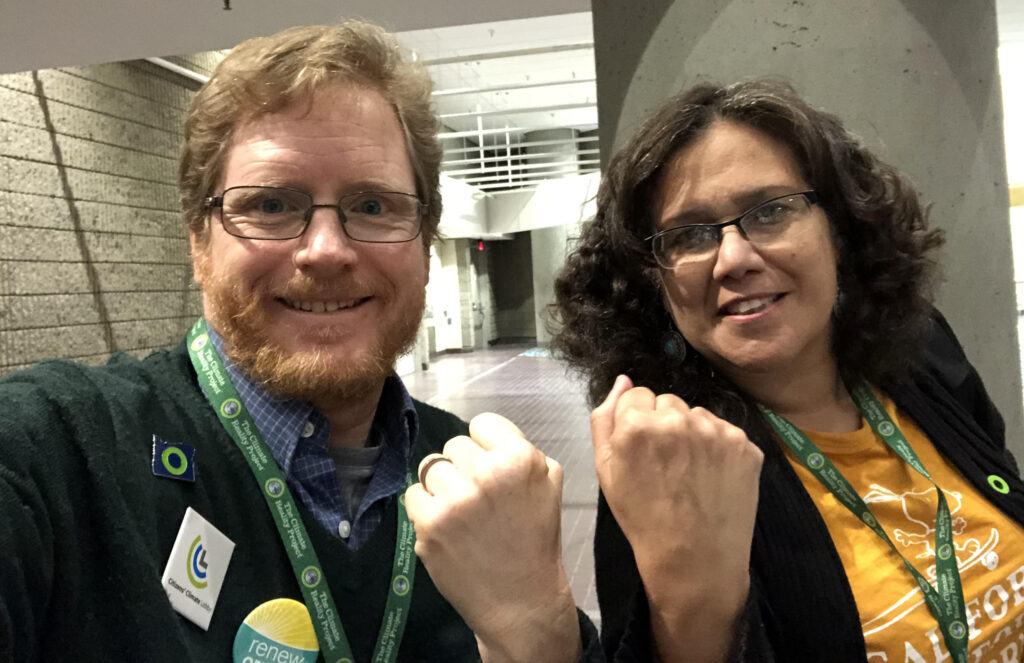
In fact, that became our theme for the new Climate Reality Leaders attending this talk, “YOU GOT THIS!” Maria even had a picture of herself in the talk not smiling with the text: “OMG!!! I am freaking out! The content and my accent!!!”
I used that phrase “YOU GOT THIS!” several times in this presentation. I started this talk borrowing from Tim Ryder’s presentation that he gave with Itzel Morales and me at the Los Angeles Training in 2018. I showed an overview of images of Al Gore’s 518 slides from his long presentation. Al Gore gave his nearly three-hour climate presentation using most of those slides the day before. In our breakout presentation, I walked through how they could find Al Gore’s slide decks on the Climate Reality Hub. I then encouraged them to use the 59 slides of Al Gore’s “Truth in 10” slide deck that is available to everyone, not just Climate Reality Leaders. It is accessable on the public Climate Reality website. The Truth in 10 slides do not have any copyright limitations. They can be shown to anyone anywhere, especially if the climate presentation is livestreamed, video recorded, or uploaded to YouTube.
I then used a Dr. Martin Luther King, Jr quote:
“Everyone can be great. Because anybody can serve.
You don’t have to have a college degree to serve.
You don’t have to make your subject and verb agree to serve.
You don’t have know about Plato and Aristotle to serve.
You don’t have to know Einstein’s theory of relativity to serve.
You don’t have to know the second theory of thermodynamics to serve.
You only need a heart full of grace. A soul generated by love.”
This seemed very appropriate to use a Dr. King quote since this presentation was given in his hometown of Atlanta, GA. After I used that quote, I repeated the theme: “YOU GOT THIS!”
I might have even had Maria say it out loud for effect. I then gave my 6 tips for Mastering Presentations that I which I had been sharing since my Denver breakout talk.
When I shared my story as my first tip, I then turned to Maria and asked her to share her story.
She talked about her background with Organizing for Action (OFA) and her involvement with the Climate Change State Team at OFA in New Jersey. She then told the audience how her and her family were impacted by Hurricane Sandy in New Jersey in 2012. Even worse, her relatives were devastated by Hurricane Maria in Puerto Rico in September 2017.
In my second tip, Finding Your Audience, I gave my examples of forming a Climate Reality Meet Up Group in St. Louis, getting involved with the local Climate Reality Chapter, joining a Toastmasters Club in St. Lous, and leading the CCL tour across Oregon in October 2017. Maria gave her examples speaking to OFA, lobbying her New Jersey Assemblyman, and speaking at Columbia University. Maria also shared how she organized and spoke at environmental marches People’s Climate Movement, NJ Sierra Club, Food & Water Watch, NJ March for Science and as a panelist for a public screening of the 2017 National Geographic documentary, From the Ashes.
Maria and I tag teamed for the rest of this talk. I provided tips and examples. Maria responded with her own examples. She was lovely to co-present with as a team. She gave it her all, stepping out of her comfort zone to speak to this large group of Climate Reality Leaders.
I started the conclusion with my standard quote: “The most important person who can make the biggest impact reducing the threat of climate change is the person sitting in your chair.”
For the final slide, I showed a quote from former President Barack Obama, “We are the ones we have been waiting for!” Then Maria once more proclaimed, “YOU GOT THIS!”
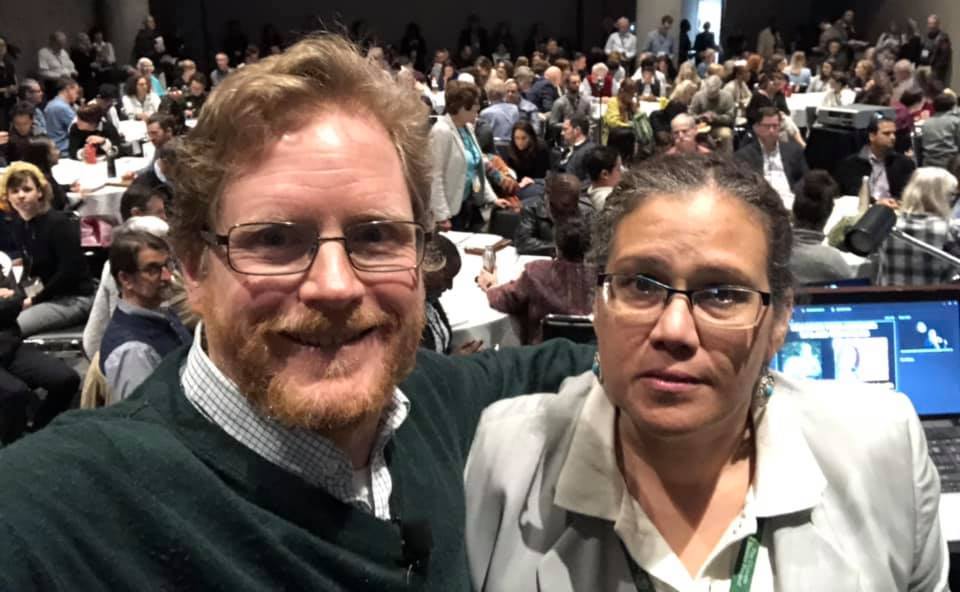
Like Maddie Adkins and Itzel Morales, it was an honor and pleasure to present with Maria. From the conversations and email exchanges with Climate Reality staff afterwards, they seemed pleased with this presentation. Unfortunately, Atlanta was the last Climate Reality Training I attended in person. I hoped to participate as a breakout speaker in trainings after that, but I was not even invited to attend future in-person trainings.
#12 North Carolina: My climate talk at NC State Parks Superintendents Conference
Sadly, when the COVID Pandemic came to dominate our lives in 2020, it killed my enthusiasm for giving public talks for climate change. I didn’t feel like speaking out about climate change when COVID was raging due to the reports of all the people dying, the economic downturn, and President Donald Trump advising people to ingest bleach. The social isolation took a huge psychological toll because I am a people person. I love to be around people to chat, network, organize, attend meetings for climate action, and entertain. With the heaviness of the pandemic hanging over everything, I felt no motivation to do anything, especially climate comedy.
Out of nowhere, Robin Riddlebarger, Park Superintendent of Hanging Rock State Park, North Carolina sent me an email in May 2022.
Robin wrote: “Howdy! Stumbled upon your (Climate Change Comedian) website as I was searching for inspiration about a guest for our annual conference of superintendents for North Carolina State Parks. I am organizing this year’s conference with three other superintendents…We want this conference to be inspiring and refreshing instead of depressing like it usually is. I’d love to find out more about your prices for doing an in-person…presentation to a bunch of crusty superintendents.”
This looked like a good opportunity to jump on, so I immediately emailed Robin back. I expressed an interest to speak to her group. In that email, I asked why they were interested in me as a speaker. Why me?
Robin’s response: “Myself and three other superintendents are brainstorming guest speakers that will inspire us. We found that we usually leave the conference feeling more burnt out than we were when we arrived. (We) are determined that this year will be different. We will at least learn something. Instead of listening to boring HR polices that could have been handled in an email.
Our staff has endured great suffering since the pandemic and morale is at an all time low. We even had a ranger take his life recently. The parks were the only thing open during the pandemic and have been loved to death. Are you sensing a theme here? We need to learn something meaningful and we need positive inspiration. The superintendents live for their parks…We care a lot. But we’re dysfunctional as heck. We don’t need team building. We are already an awesome team. We need something GOOD. Is this anything you would want to tackle? (I’m laughing because obviously climate change is not good, but you know what I mean).”
Robin’s email touched my heart. As a professional speaker and former park ranger, it seemed like an ideal fit for me. I decided to give a presentation that could provide hopefully some healing, entertainment, and inspiration for them.
The North Carolina State Parks Superintendents Conference scheduled me to speak on November 14, 2022. My title for this talk: “Our Parks: Places of fun, healing, and inspiration to change the world.” This was my first in person talk in almost three years. The superintendents laughed at some of my jokes, but my timing was rusty since I had not performed live in years.

With her approval, I included Robin’s email to me in my PowerPoint why she thought I would be ideal to speak at this conference, “Instead of listening to boring HR polices that could have been handled in an email.”
When I shared Robin’s HR comment, it received a big laugh from the audience. The organizers of this conference joked about that line afterwards. They were still making jokes about dry HR presentations the next day.
I felt like I got my groove back with this talk. I did not know when I would return to North Carolina. In October, I messaged friends that I knew for many years that lived on Ocracoke in the Outer Banks if I could stay with them. They said yes. However, they insisted that I ‘sing for my supper’ by giving a climate change talk to over 50 middle and high school students in Ocracoke. Thus, I ended up giving two climate change talks on this 8-day trip to North Carolina.
While I was in North Carolina, I rented a car from Raleigh to the Outer Banks. The drive from Kill Devil Hills on the northern part of the Outer Banks to Ocracoke was stunningly beautiful with the beaches, lighthouses, and impressive bridges and ferries connecting the islands on the Outer Banks. My talk for the middle and high school students in Ocracoke went well overall. Teens are generally much tougher audiences for the jokes I like to share during my presentations.
It felt like I was back to my old self before the pandemic of traveling to other states once or twice a year to give climate change talks and doing sightseeing in between those talks. I will keep my fingers crossed that I will get more invitations like this in the future since I definitely seem to be a big step up from talks on “boring HR policies.”

Final Thoughts
Ok. I will admit. This blog is more like a book than a blog. My intention was to write about my breakthroughs of speaking on climate change in new states, as well as Washington D.C. and Ottawa Canada. Bless you if you made it all the way to the end. I wrote this blog for me. For me to document in one spot all the states, plus the world capital cities where I spoke.
When I gave my first climate change talk at my nephew Sam’s school on February 5, 2010, I had no idea that I would end up giving over 200 climate change talks in a dozen U.S. states and even outside of the U.S. I had no way of knowing that I would end up on national TV a couple of times, speak to over 200 people at the Grand Canyon, and be a breakout speaker at three Climate Reality Trainings led by Al Gore. I hoped something like this would happen to me. It is always completely unknowable what will happen in the future.
I still hope to give more climate change talks in more U.S. states, unusual locations and even internationally. I hope to give a TED talk and speak at prestigious locations. The invitations I receive come out of the blue very serendipitously. They just happen when they happen. The key is putting myself out there so more opportunities do happen. If you are reading this, I hope you will take a chance on me.
I want to use my life energy to create a higher consciousness for more climate action while having fun doing that. Most of all, I want to inspire you to up your game to act on climate.
Thank you for reading this!
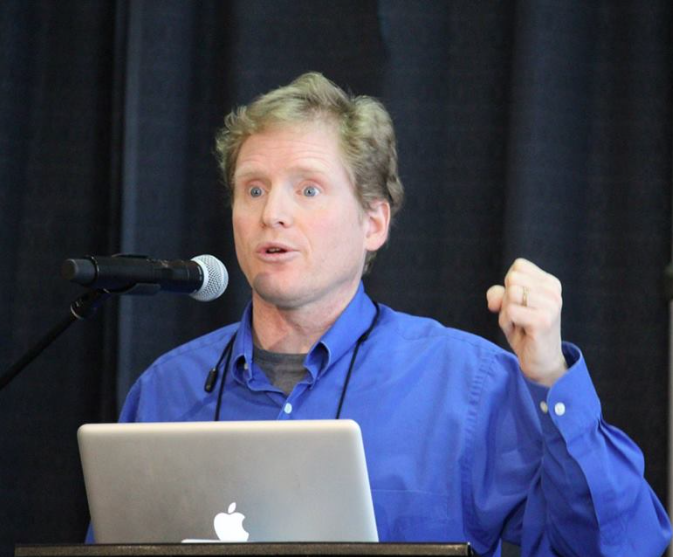
- Correction: In writing a previous blog, I discovered that quote is misattributed to Maya Angelou. According to the Quote Investigator website (QI), which “records the investigatory work of Garson O’Toole who diligently seeks the truth about quotations.” According to QI, the quote actually originates from “1971 collection titled “Richard Evans’ Quote Book”. The statement was ascribed to Carl W. Buehner who was a high-level official in The Church of Jesus Christ of Latter-Day Saints.”
